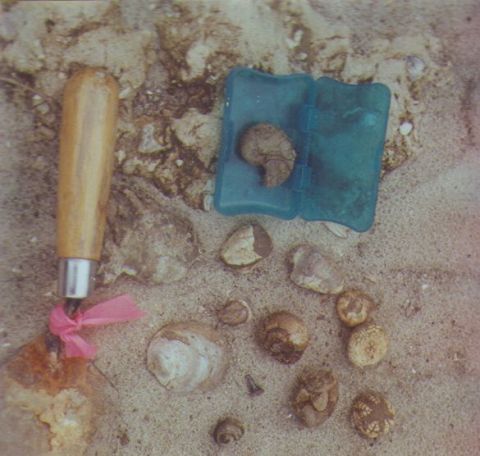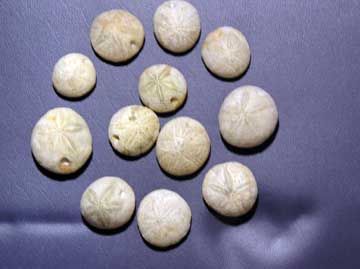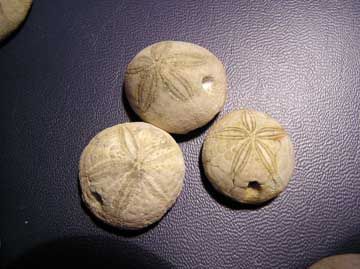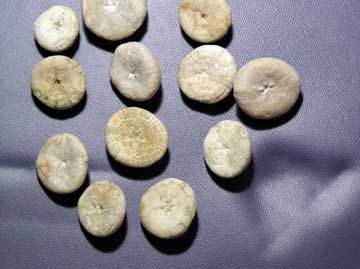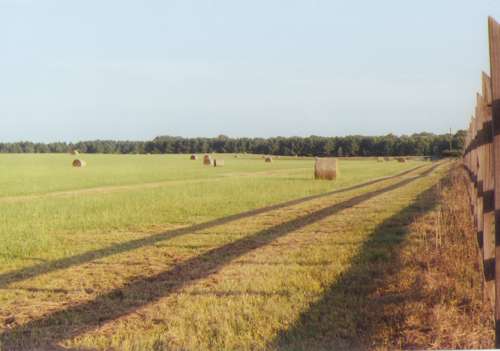A closeup of the banks along the creek.
2004
January 24, 2004 - Cambrian Fossils, Cherokee Co, AL
Our first stop was at a new site exposing nodules from the shale of the Conasauga Fm, Dresbachian stage, late Cambrian approx. 515 million years old. Here we found over 20 "Brooksella" which are believed to be the internal mold of a "primitive jellyfish". The most that anyone can remember finding on any trip were 3, so everyone got at least one specimen.
The second stop was an old BPS stand-by trilobite site from the middle Cambrian Conasauga Fm. Albertan stage 530 million years old. Here everyone found a number and variety of trilobites both on nodules and by splitting the shale exposed on the beach. Cephalon (heads), pygidium (tails), and in a few cases whole specimens of the following were found: Coosella, Coosia superba, Kingstonia, Densonella, Holcacephalus, and Norwoodella.
We made an interesting trip to a third stop which turned out to be unproductive. But it did include being lead into the site by some locals on horseback, and one of our younger members got a ride on one of the horses.
Then we moved on to our fourth and final site that Steve C. found on a scouting trip near Cedar Bluff. This site was still in the shales of the Cambrian (but not sure what stage) and deserves a closer look when time allows because even though not many trilobites were found, the pieces that were found seemed to be large ones, possibly of Tricrepicephalus.
--Edited by Vicki Lais
Below are some great photos Greg took with his new digital microscope. Other photos courtesy Vicki Lais.
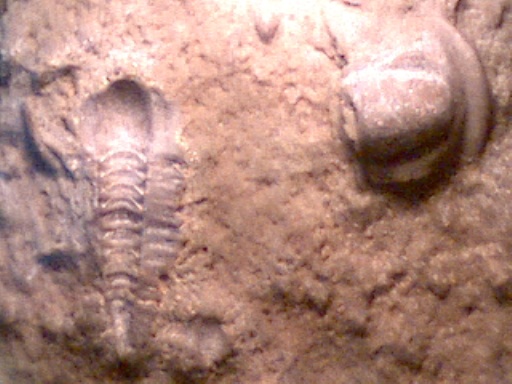

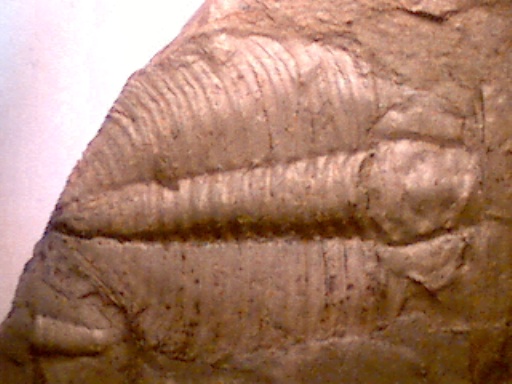
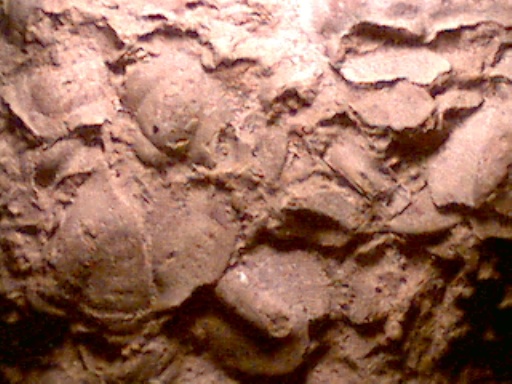
BPS members searching for Brooksella at a site that hasn't been visited in many years.

Showing off their finds.
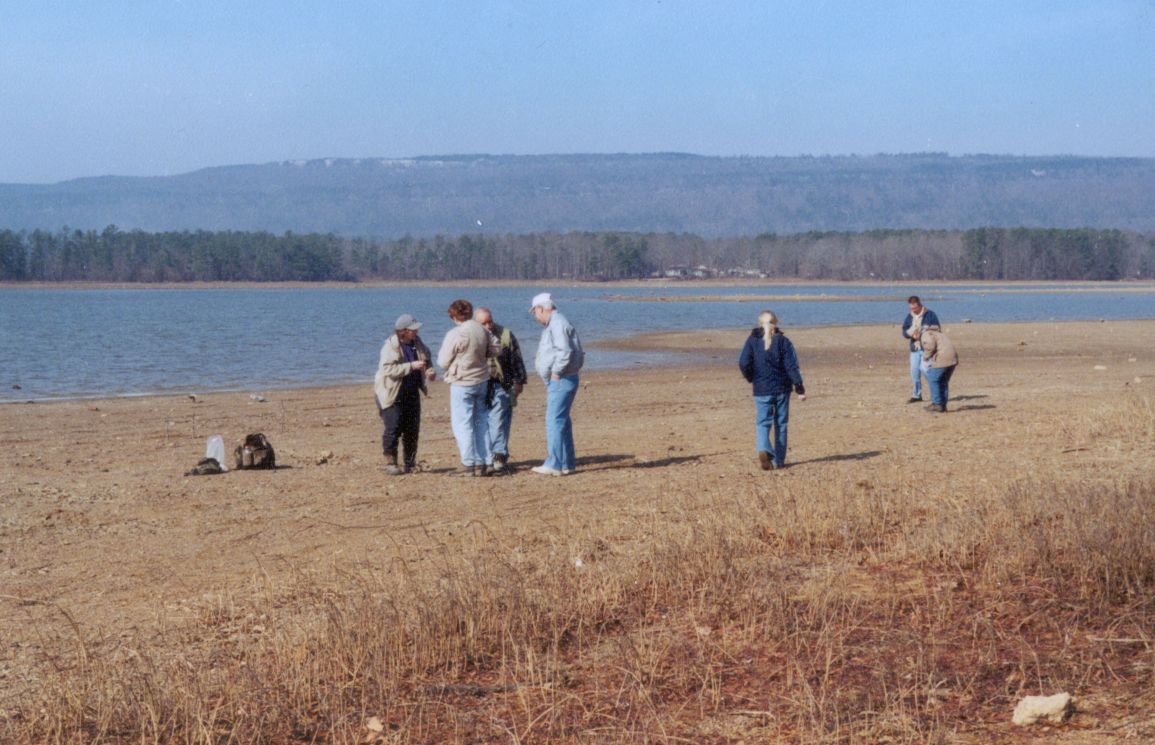
A nice collection!
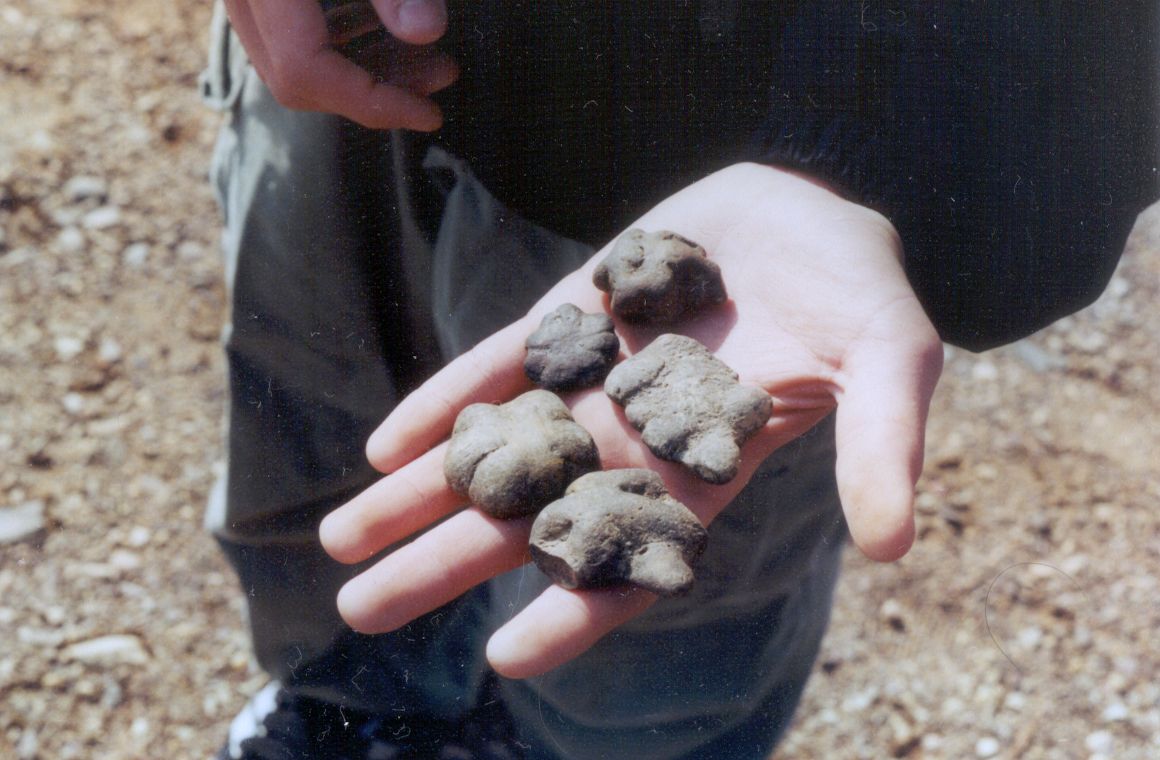
A new site. Found a large trilobite here, but was getting late, and only did a short site survey.

One never knows what
opportunities might
arise. Young Steve got the ride
of his life from one of the locals who guided us to a site.
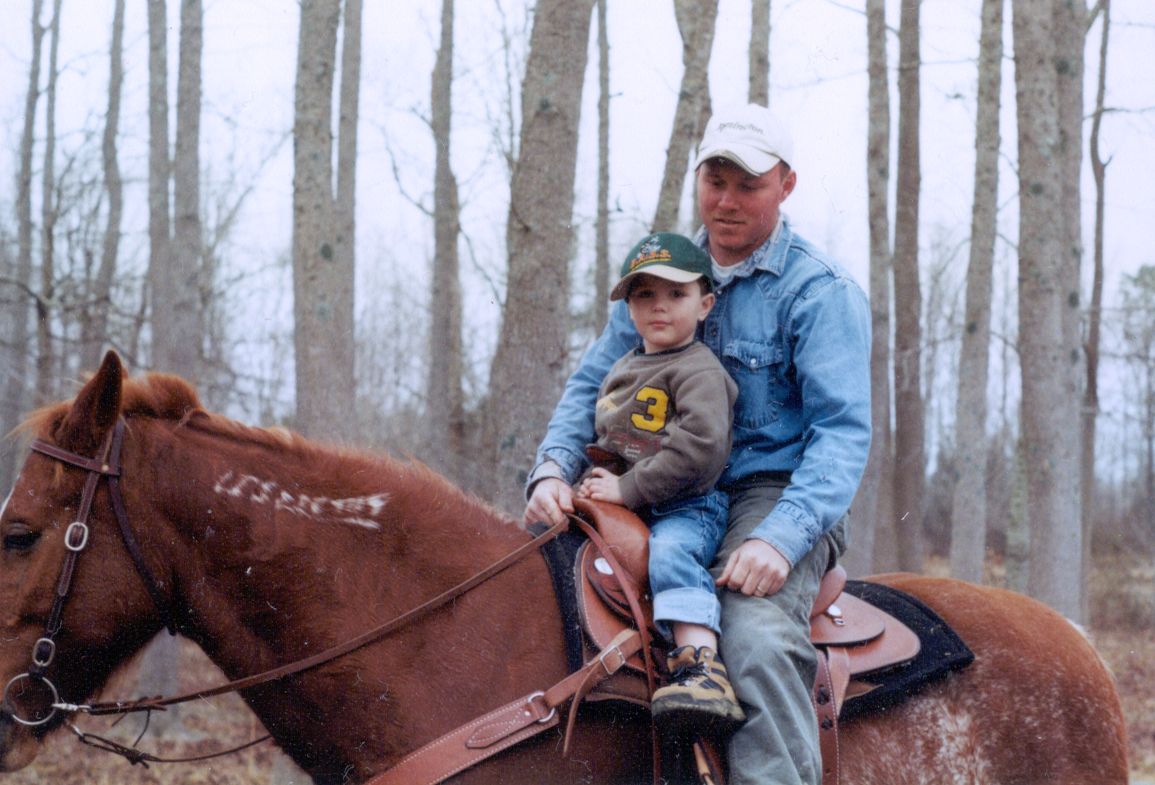
Nice find! 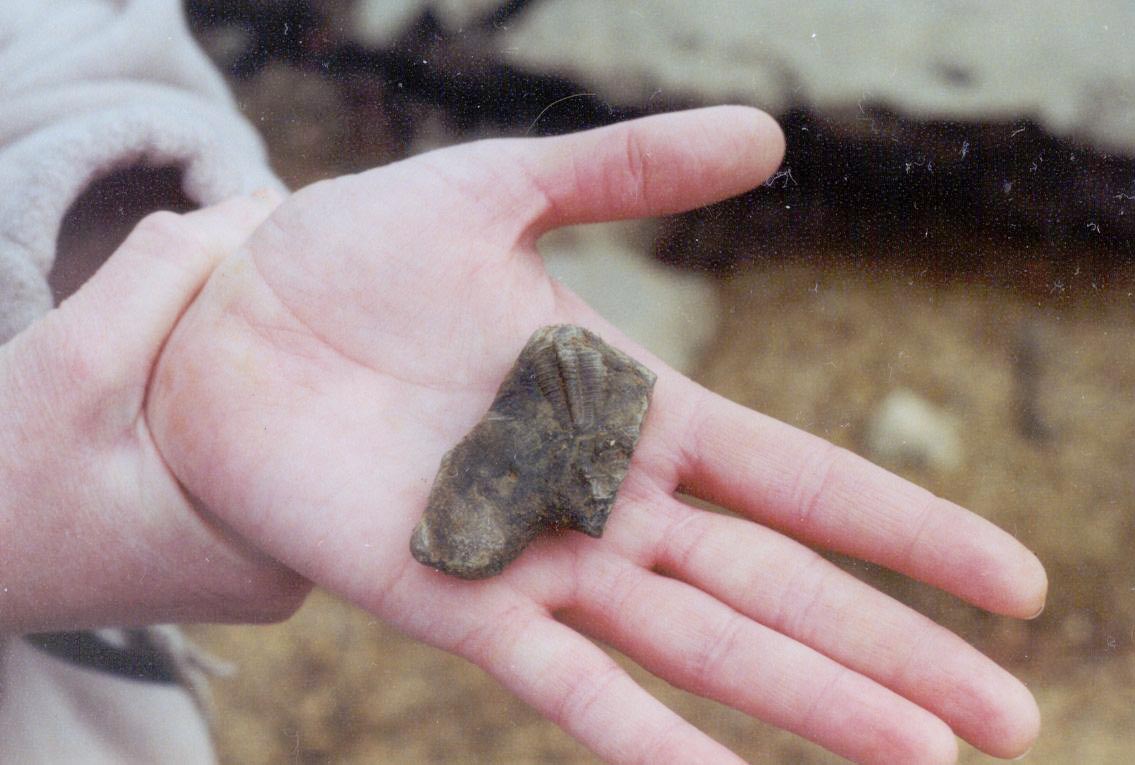
February 22, 2004 - Jefferson Co, AL
Some of the new members got a brief tour of the quarry and Nancy got to play with her new photo equipment. The small boulder we had chosen on an earlier trip was re-located and we went to work cleaning and preserving it. The results were better than expected and many more "critters" were found on the stone than expected. However, attempts to do a rubbing of the stone failed due to the texture but Nancy came to the rescue. She took some great photos using her SLR digital camera and by using "PhotoShop" was able to make a virtual rubbing that I think will work better than the real thing. This "rubbing" is to be used in the educational pamphlet for RMNC and being digital, it will be easier to edit. Even though we could not do any collecting for ourselves we did find a few interesting items that could be preserved and put into the RMNC collection along with the display we are building for them. It is fun giving something back to the city that has been the home of BPS for the last 20 years.
(Photos courtesy Nancy Kenfield and Vicki Lais.)


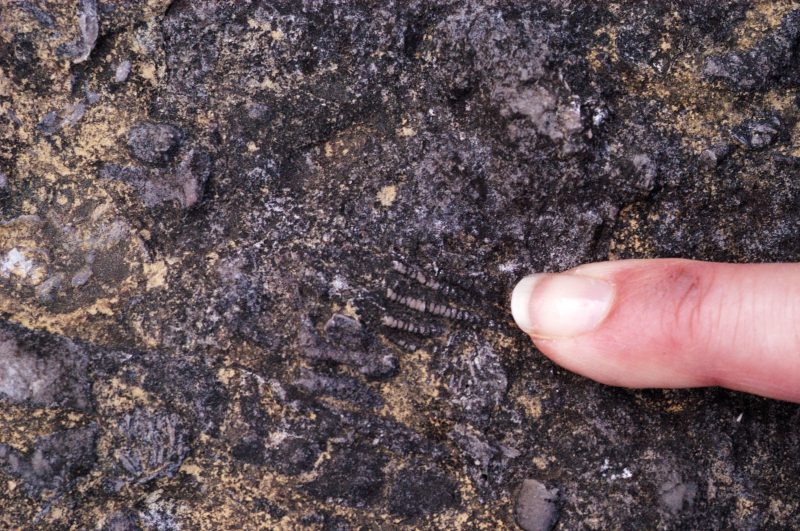
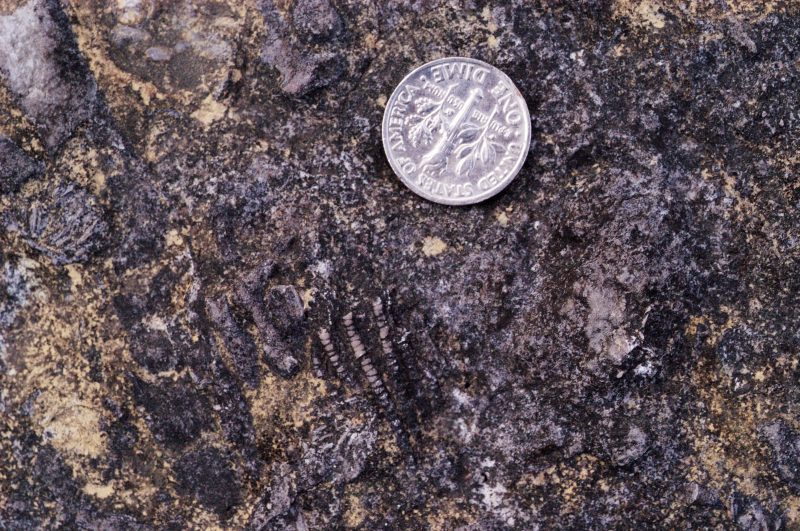

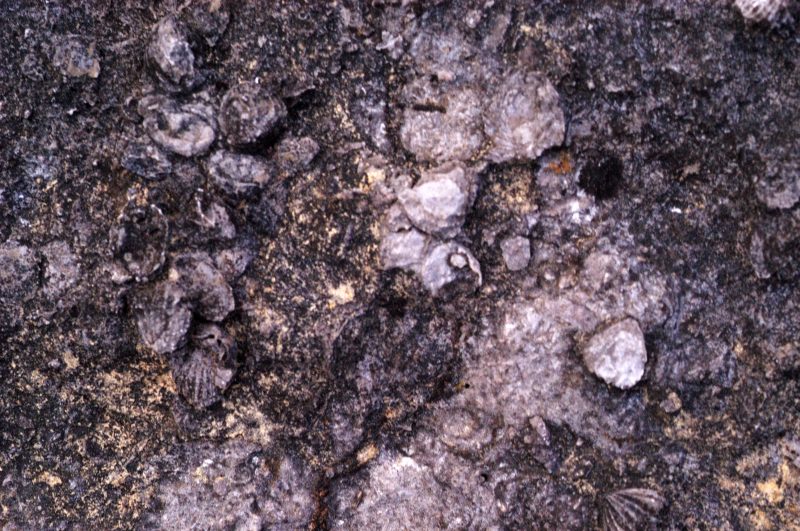
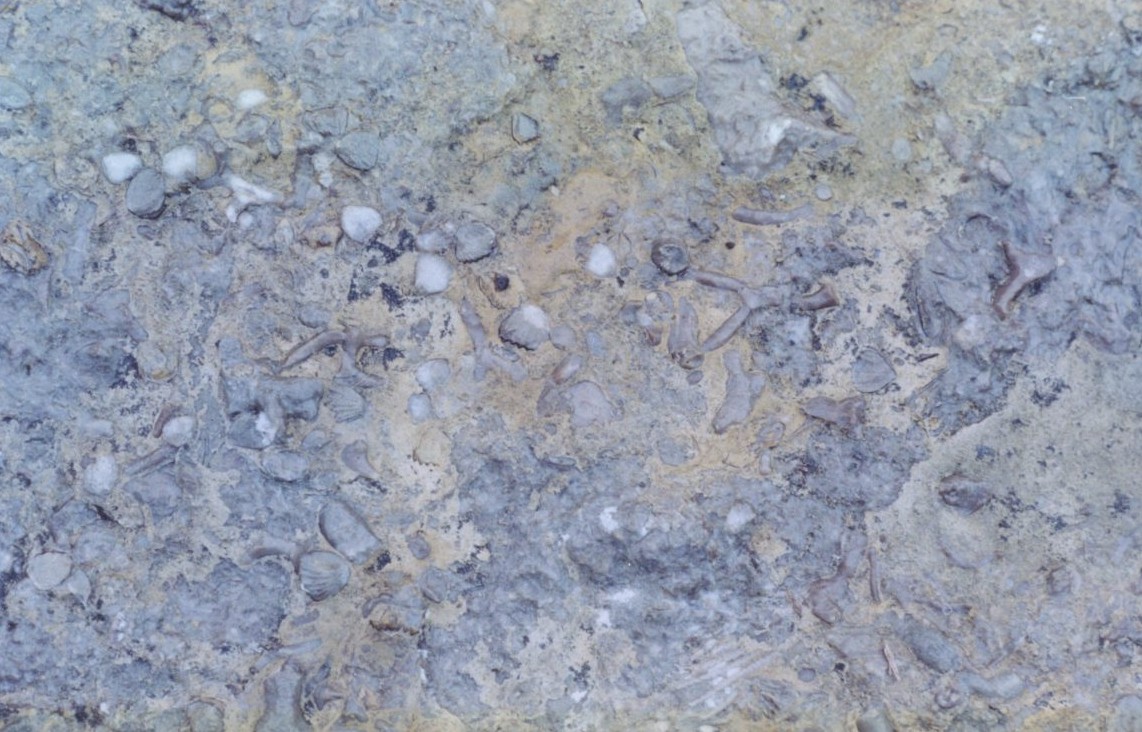
Everyone trying to make a point. . . .
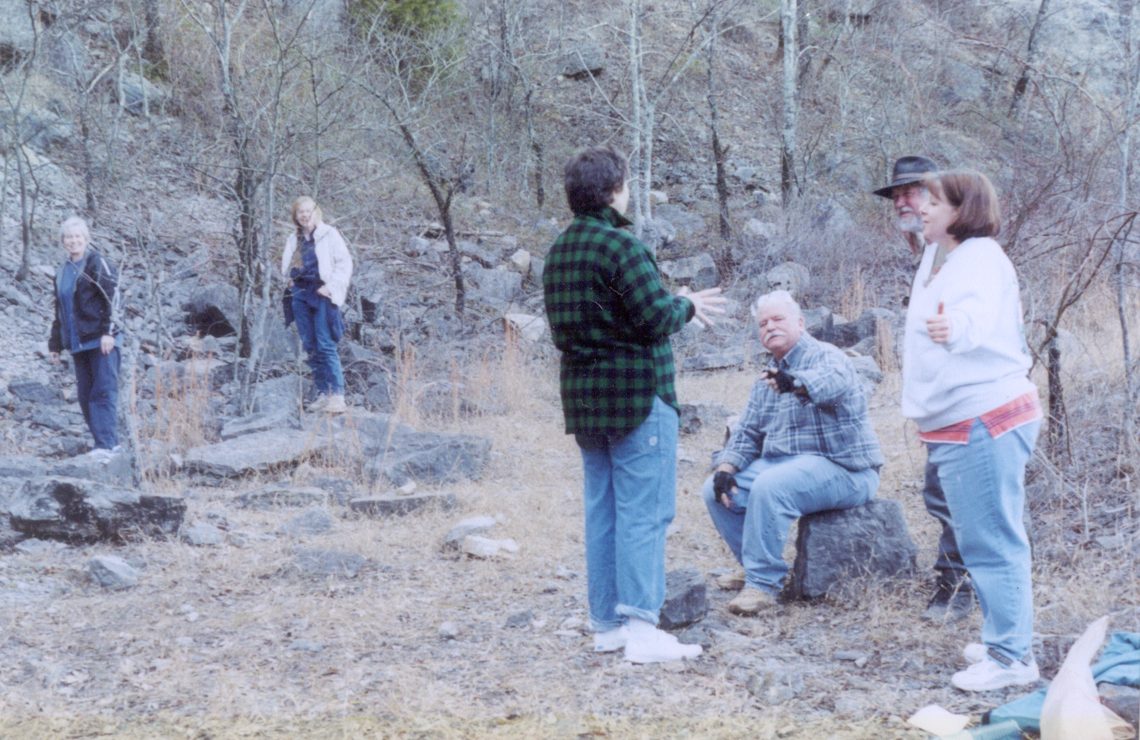
March 13, 2004 - Mississippian Fossils, Morgan Co, AL
We began our field trip for this month at a quarry in Jefferson County, to view specimens in the quarry classroom. Then we caravaned to the collecting site in Morgan Co, AL (except Vicki, who was talking so much to Bill and Adelle that she failed to see everyone else passing her on the interstate ...)
We had a wonderful day of collecting, beautiful weather and great turnout. We went to a new spot in the quarry, in addition to the site from last year. Collecting is in the Mississippian Period (340-310 mya), in a very hard limestone. Every member had great finds, including crinoids (including arms and calyxes), blastoids, brachiopods, coral, and sharks teeth (believe it or not!). Proper prep work will make these specimens stand out beautifully.
(Photos courtesy Steve Corvin, Bill Cunningham, Vicki Lais)
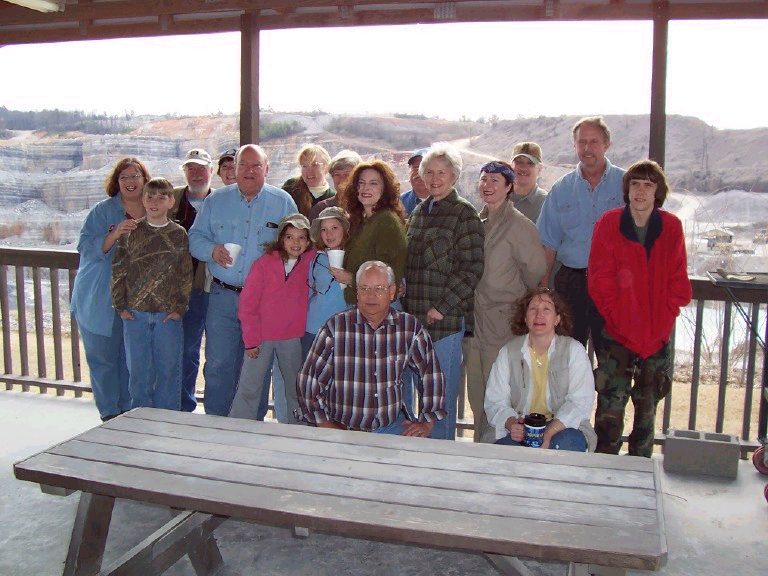
We're ready!
Inside education building, viewing the display.
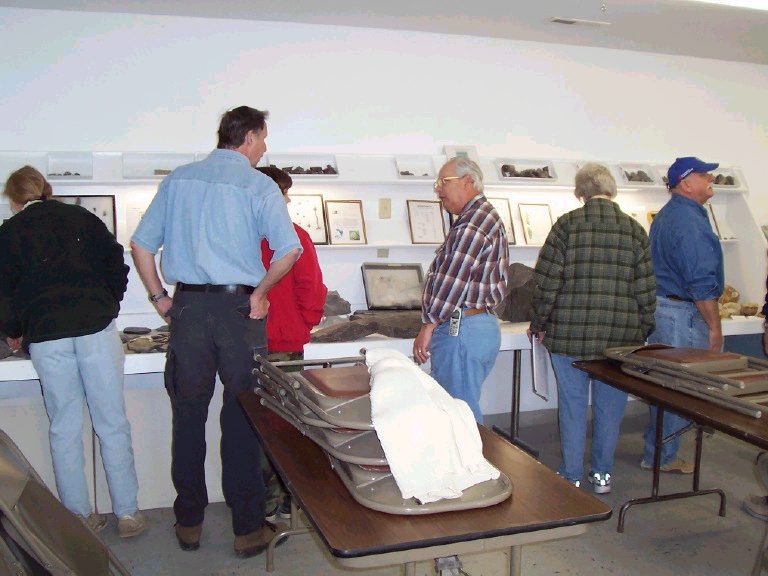
View of the Tarrant quarry.
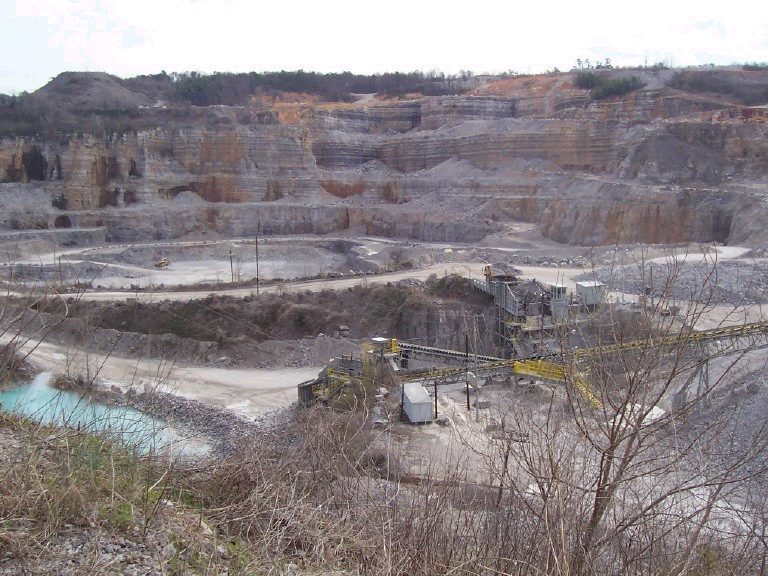
BPS members searching in the boulder piles.

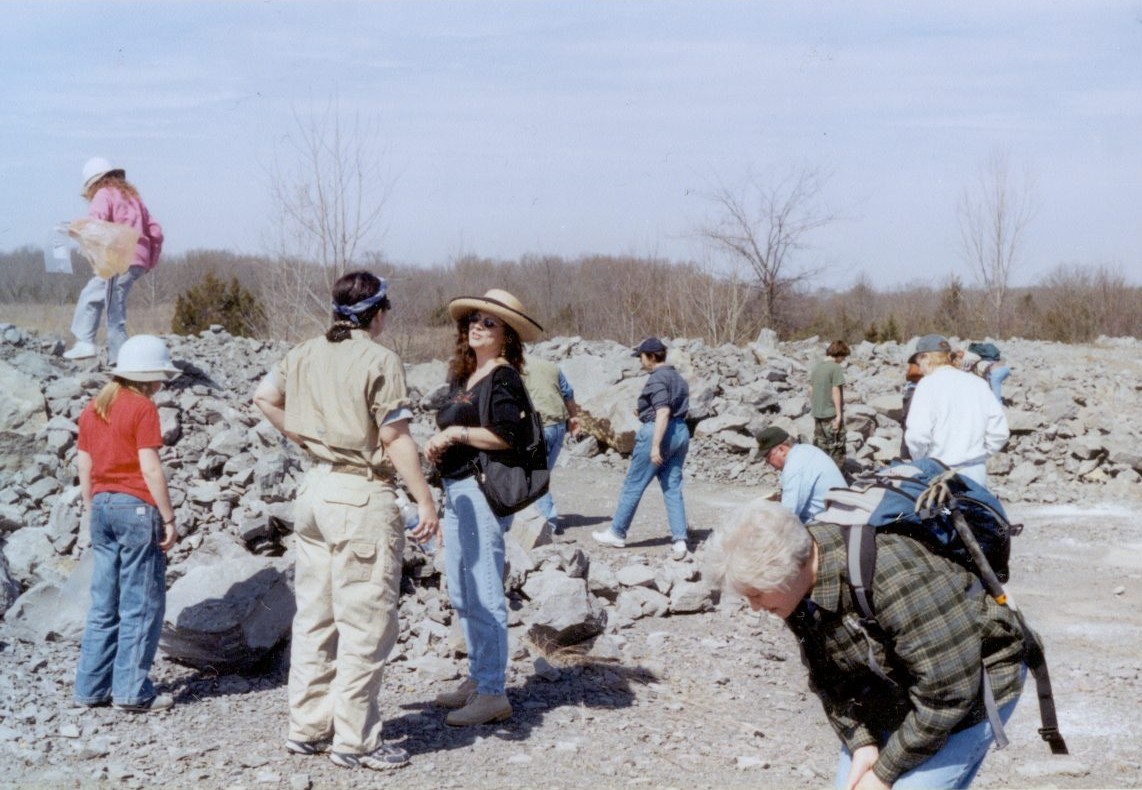
Was it worth all the searching? We think so. Nice crinoid.
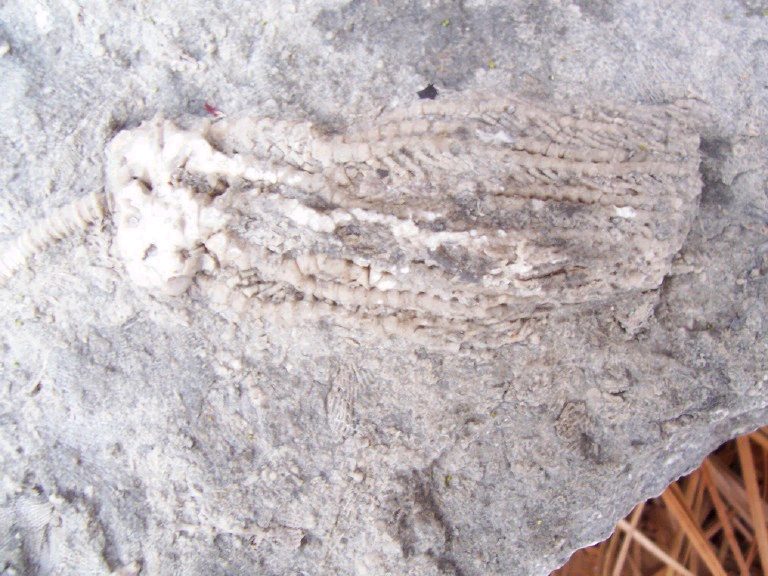
Rock filled with crinoids and blastoids found by Vicki. Click rock for larger image.

Typical fossils found at this site.
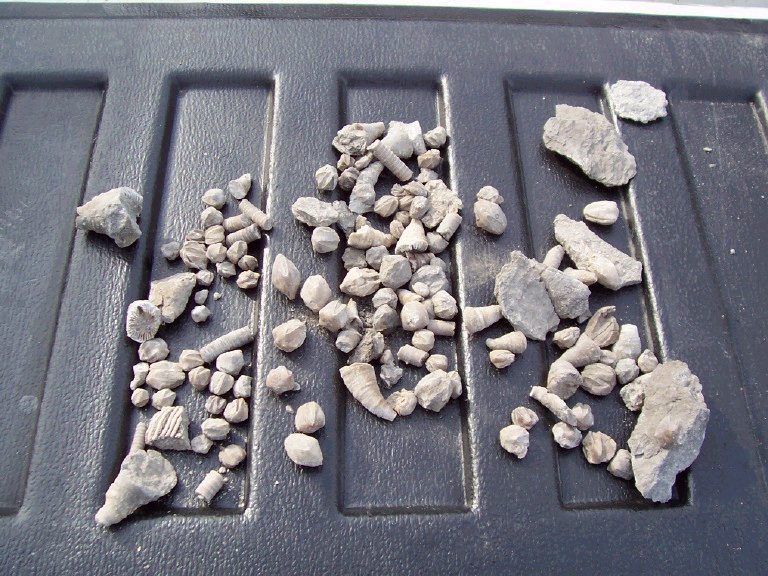
April 17, 2004 - Cretaceous and Pleistocene Fossils, Greene Co, AL
A number of teeth from the Goblin shark and crow shark were found by all. (See the July, 2003 trip report for details on these sharks, and more on the geology of this site.)
(Photos courtesy Vicki Lais)
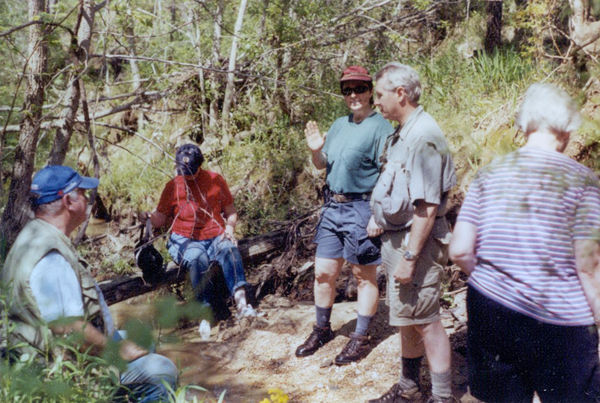


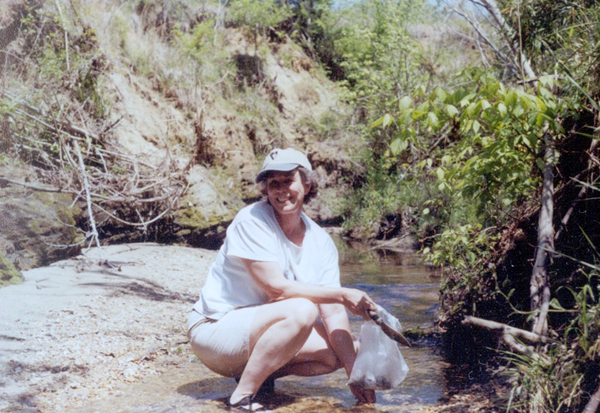
Ann and her bag of treasures.

Nancy showing off her ptychodus tooth.

Vicki dumped her bag to show what she had collected so far. A number of shark teeth, some in matrix, bone fragments, and several "interesting unknowns".

How many hours do you think Claire and Ann can do this?
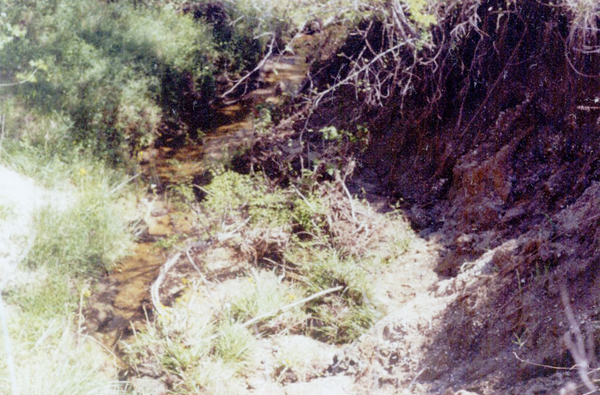
A small canyon that proved interesting. A little out of the picture one can see the strata where the teeth and pea gravel have been deposited in the bank.

Climbing down into the canyon. (they keep telling me to quit taking pictures of rear ends....)
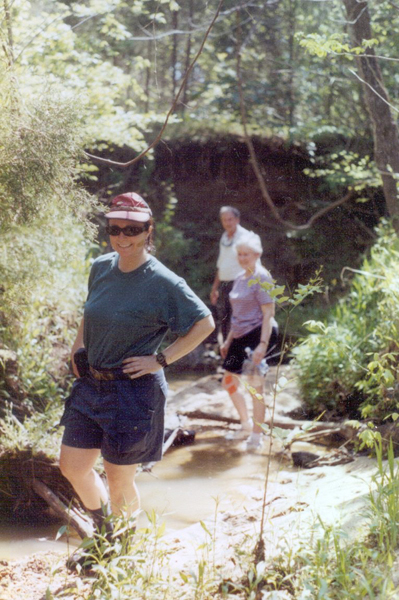
Lisa, with Jan and Bobby in the background. Steve was always somewhere way up the creek or way down the creek, and managed to totally avoid the camera.
May 22, 2004 - Cretaceous Fossils, Sumter Co, AL
As Bobby came over to see what all the fuss was about, he saw "odd shapes" sticking out of the chalk about 15 feet before he got to where Greg was working, and after looking closely, realized it was several more vertebra. Steve came over to assist in excavating this new pile of bones. The other part of the group had gone to another nearby beach, and were basking in the sun (and I suspect they went swimming based on Nancy's drenched appearance!). They decided to ride back over after all the hard work had been done, and see what we had found. Then Jan asked if we had looked under that tree trunk beside us. Well, no. So the trunk was moved, and low and behold, there were about 5 more vertebra under it, which were also excavated. So this was truly a group find, and everyone got to work on the excavations, initial cleaning, and proper packing.
Bill, with the assistance of Leisa, did a great job on the site survey and drawings. Greg, who worked many years with the paleontologists at Red Mountain Museum, supervised the excavation and has been preparing the fossil bones for display. Thanks to all for the fine work and photos! (NOTE: any professional paleontologist who desires to study these fossils, please send your request via email.)
Afterwards, a number of members went to another river site in Sumter county to collect marcasite.
Bill Cunningham also contributed to this report.
(Photos courtesy of Nancy Kenfield, Bill Cunningham, Vicki Lais, and Greg Mestler.)

WOW !
(Click images for larger view.)
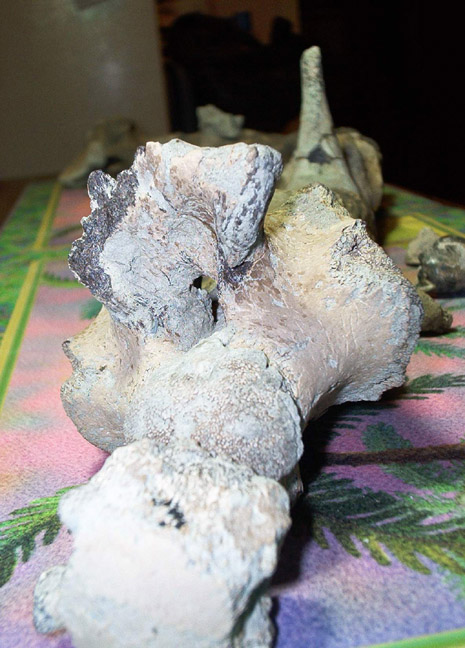

Lets get going!

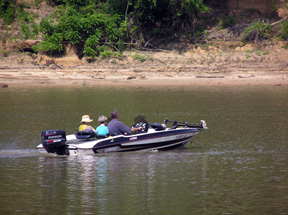
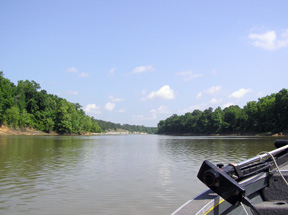
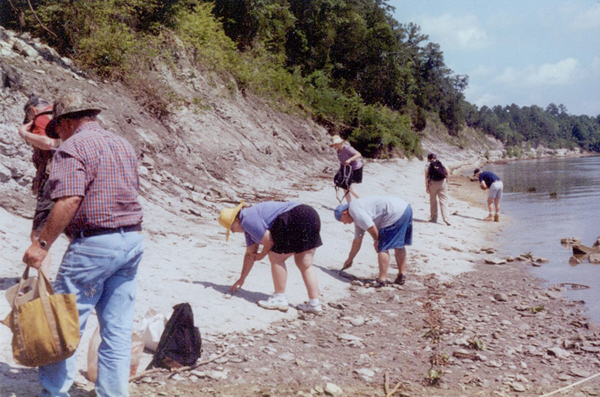
Hey, guys, pose for me!

In large photo above, this is the leftmost vertebra, immediately after excavation.
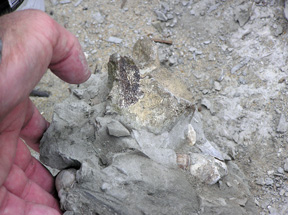 Top view of vertebra.
Top view of vertebra.Bottom view.
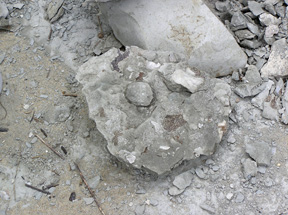

One of the many gastropods found.
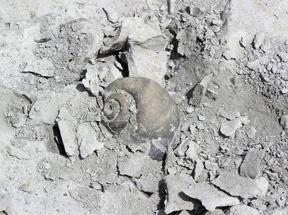

What did you find?


Vertebral column extends 7 meters from near Coke can to several feet beyond the excavators.
Yes, we get dirty.


The excavation site had a small drainage problem...

Samples of typical finds - ammonite, straight cephalopod, gastropod, turritella, limpet, oyster.

Steve with his latest treasures.

Bobby washing mud off the vertebra.


Group of eight vertebra.

Three vertebra in situ (about 15cm apart)

A vertebra in matrix (caudal concave discoid about 5cm)

Ammonite impression (about 30cm)
Local wildlife.

Water hyacinths are pretty, but is an invasive species that destroys our rivers and lakes, and it is prohibited to sell it in the state of Alabama. Thick infestations can make boating or swimming impossible.
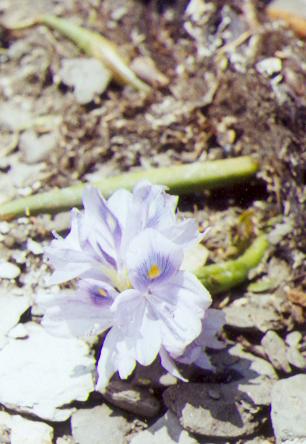

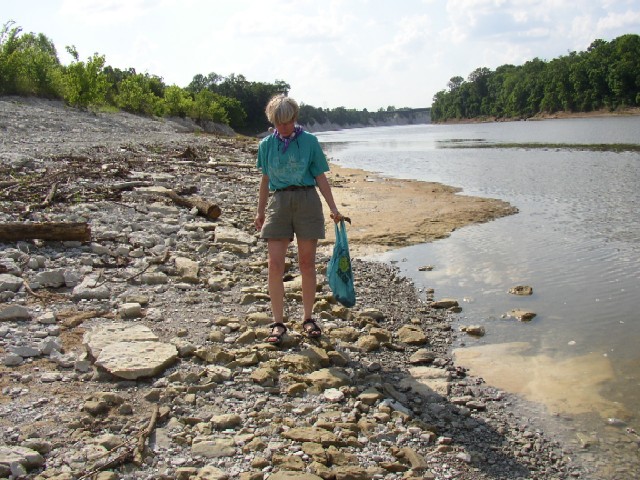
Several members traveled to another Sumter County location to collect marcasite.

White chalk cliffs in Sumter County, AL.
June 26, 2004 - Late Cretaceous Fossils, Montgomery Co, AL
(An Account of Unprecedented Creek Crossings)
BPS members visited a late Cretaceous site in
Montgomery County, Alabama, where we collected primarily
echinoids, gastropods, and a few shark teeth. This trip was a
real adventure!
A week of daily summer rains and pictures from Friday's site
reconnaissance were not enough to daunt those needing a field trip
fix. By mid-day Saturday the water had receded enough to give
hope to those who had been standing on one bank of the creek and
staring longingly at the other bank. There was a spark of
hope.
At lunch it was decided that after a trip to a second site
that enough
time should have passed and the creek could possibly have receded
enough to be crossable.
Steve waded the creek with one end of a 60 ft rope in
hand. Once
tied off on both sides the rope was a sufficient balance for a slow and
steady crossing. There were crossers who faced downstream,
crossers who faced upstream and those who sidestepped their way
across. All present decided to journey to the other
side.
And by my count - taking the rope and escorting 6 people X two = 22
crossings for Steve.
Flood level water the day before washed out good material for
collecting, and yes, we finally needed that change of dry
clothes.
--Edited by Vicki Lais
- - "TALES FROM THE
PAST" BY JAMES
LAMB - -
(Photos
by Nancy
Kenfield and Vicki Lais)
July 31, 2004 - Monroe Co, AL
Members participating in this long trip were Greg, Jan, Steve, Leisa, Gilbert, Carolyn, Vicki, Nancy and Miss Daisy.
(Photos courtesy Nancy Kenfield, Steve Corvin, and Vicki Lais)

Along the shoreline.
Greg and Steve, getting ready to check out this landing.

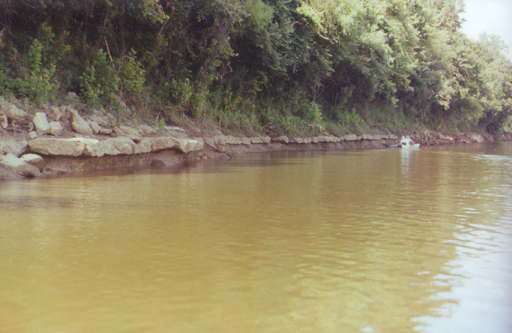
Shells in matrix. Sand is wet, and shells will disintegrate at the slightest touch. Careful excavation is essential.


At slightly higher elevations, the shells are dry and hard. Leisa found these.

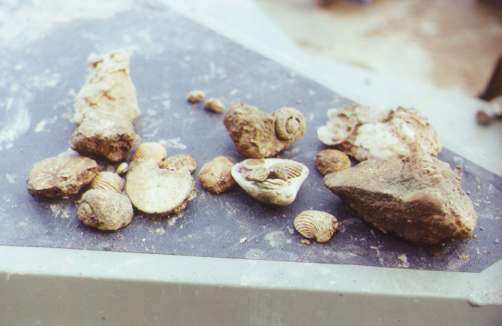
A representative sampling of shells in this locality.

Shell impressions.

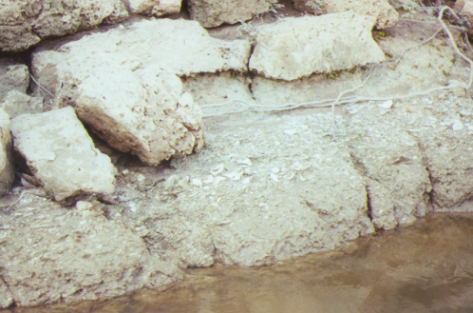
Shell layers in the bank.
Turritella found by Steve.
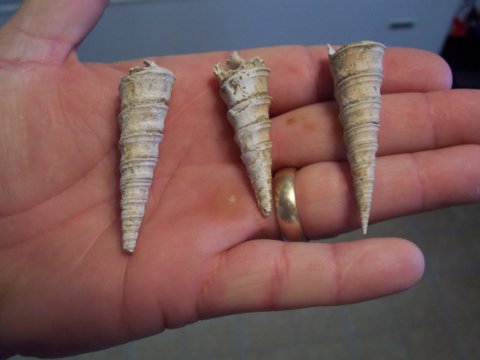
Sand dollar found by Steve.
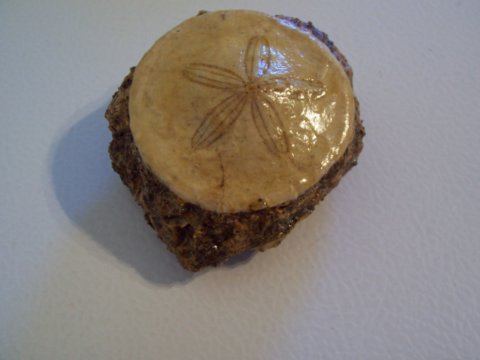
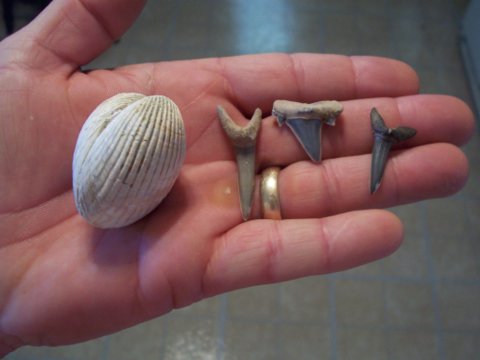

Nice collection of sand dollars found by Steve.

Large boulders, appearing to be trace fossils, perhaps burrows.

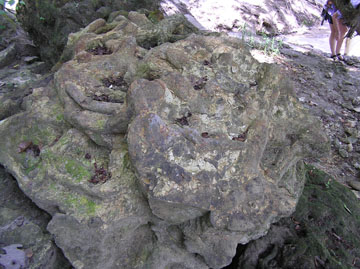
Many of the burrows had shells inside.
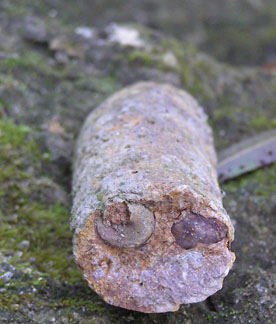

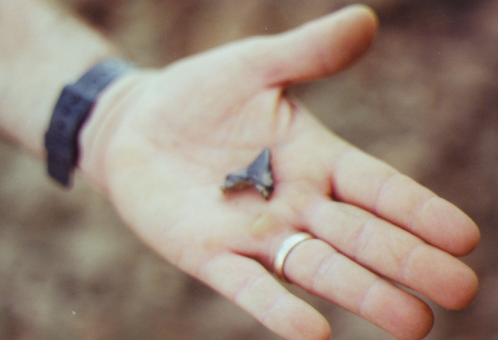
Tooth found by Steve.
Gilbert after a long hard day on the river.

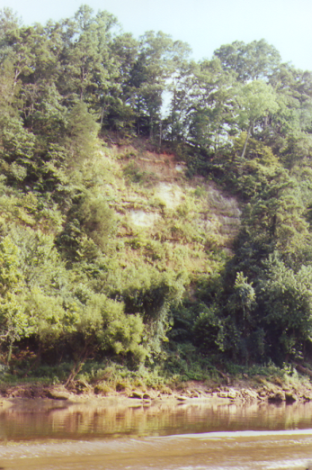
A view of the bluffs, mostly grown over now.

End of another great collecting day!
On the way down, some of us apparently took a wrong fork in the road.... that sign was deceiving.

August 28, 2004 - Cretaceous Fossils, Butler Co, AL
(Photos courtesy Vicki Lais)

One of the first items found. Forgot to put a scale in the photo, but this gastropod is approximately 4 inches long.
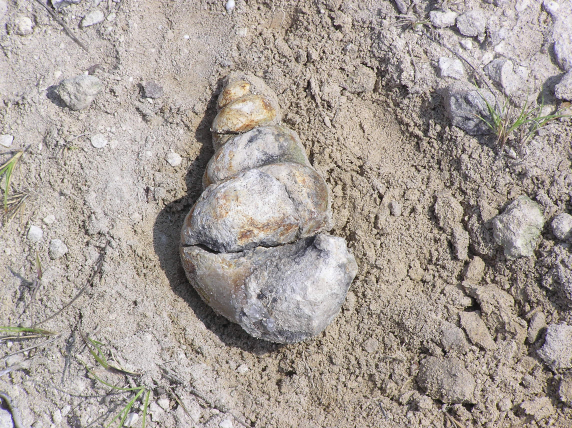
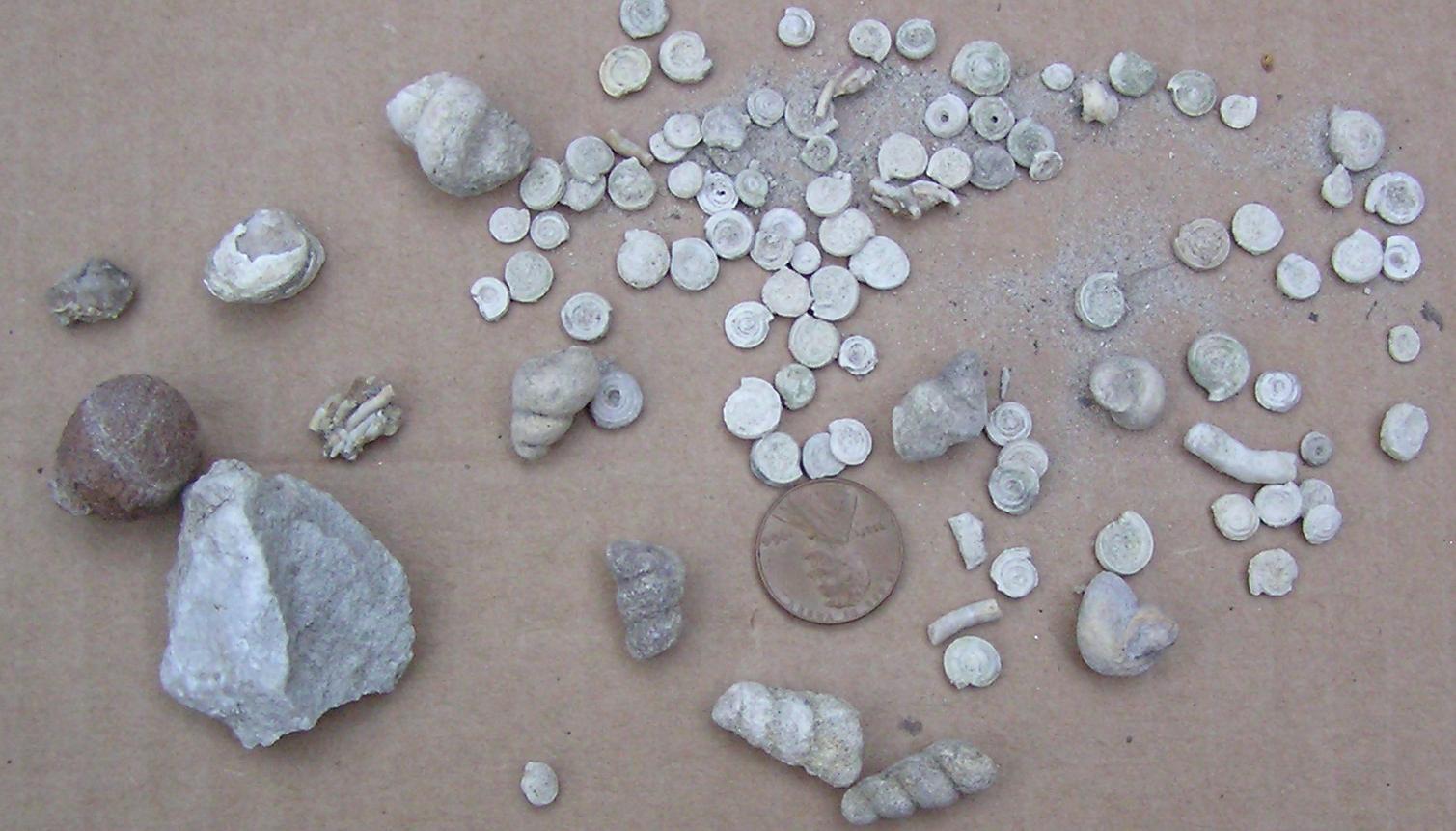
These tiny round gastropods are common on the ridge. Turritella, bivalves and worm tubes are also found, but are not as common.

Boy, was it hot on that ridge! Let's go to the creek! Becky, Carolyn, and Nancy
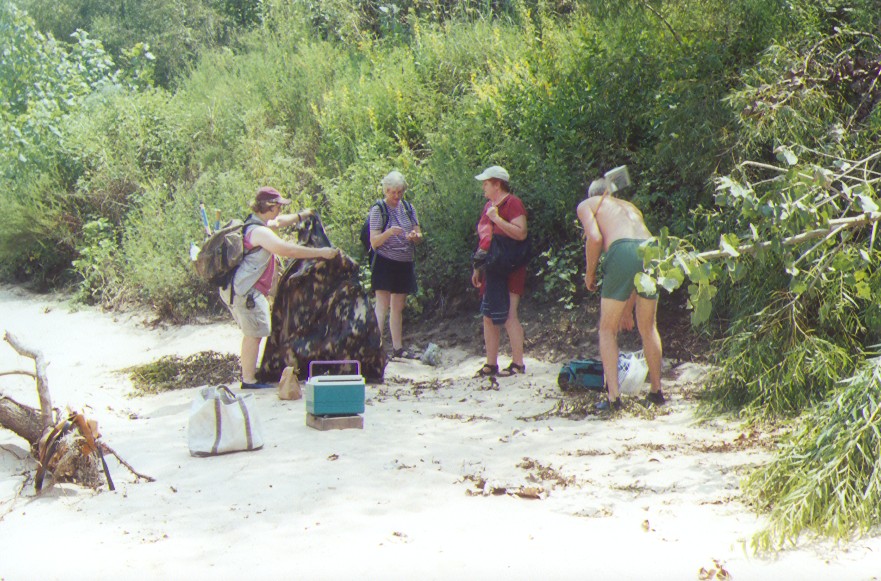
Getting ready for the hunt.
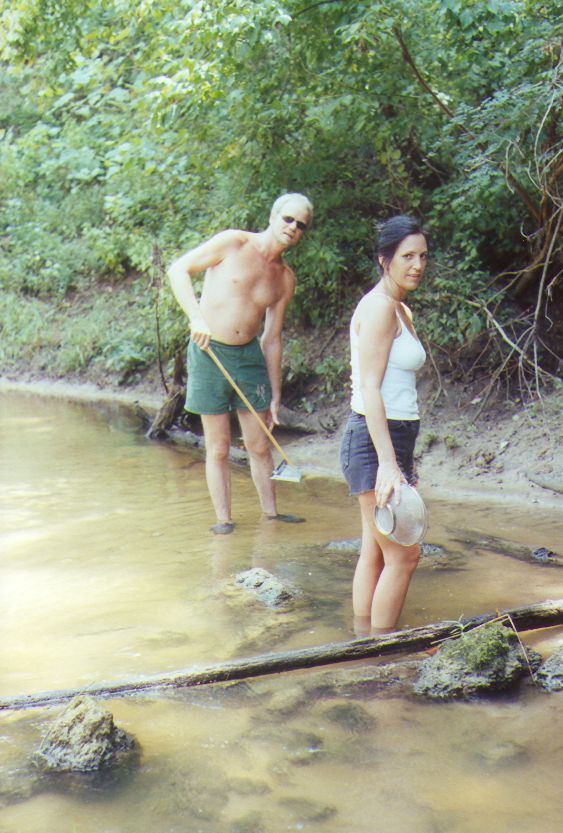
Ramsey and Sarah get started.
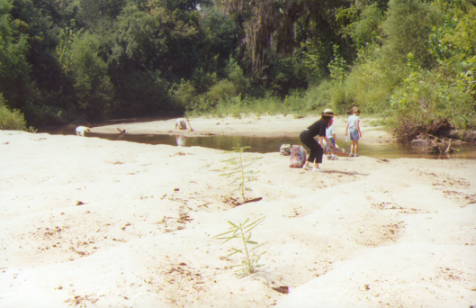
Leah and others heading up the creek.
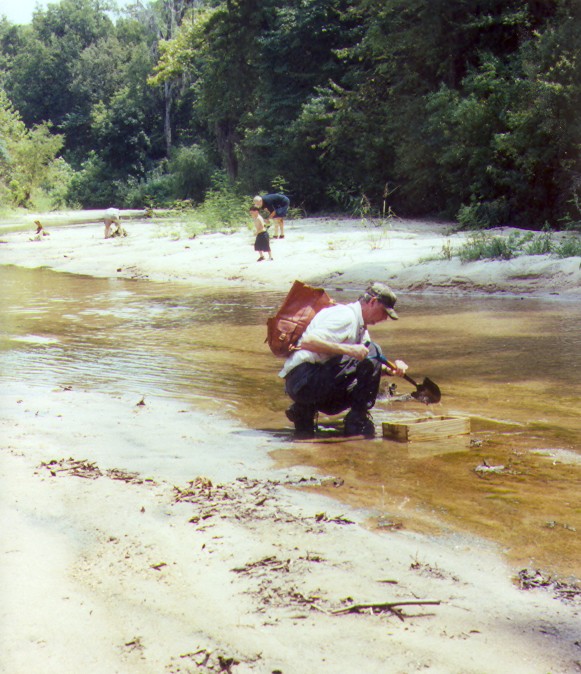
Bobby sifting through the gravel.

Nice gastropod.
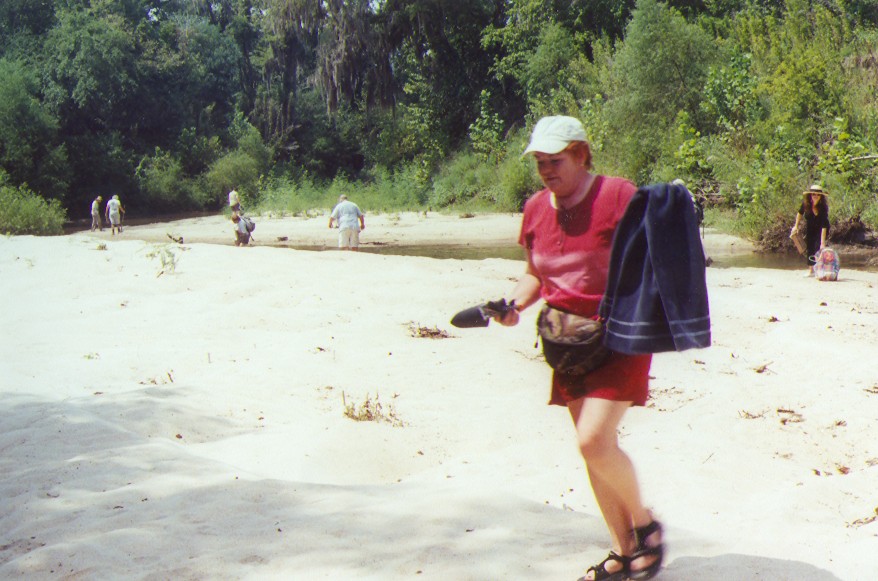
Some of the troops head downstream. . . .
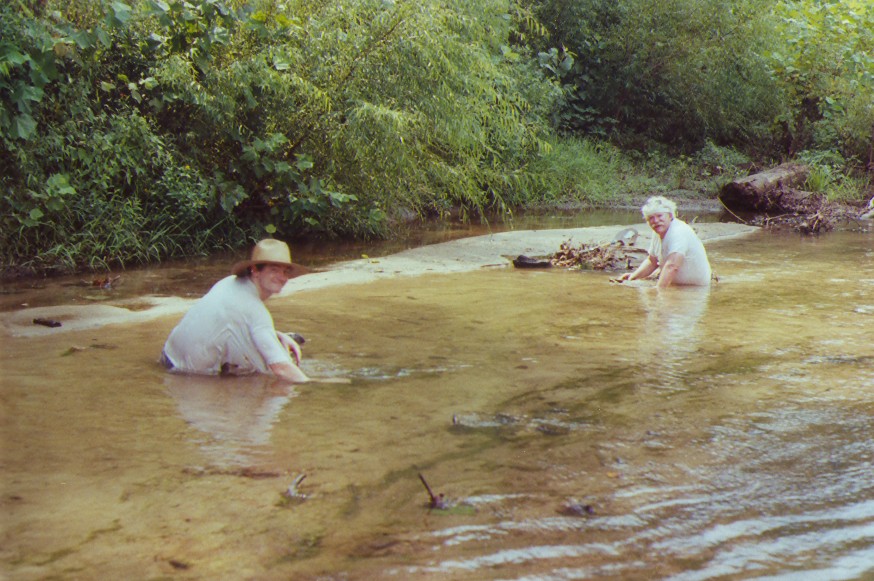
While others (Wes and Jeff) decided to stay put for a while.

Claire and Nancy find a good spot for lunch way upstream.

Nice artifacts found by Jeff and Wes.

Small nautaloid.
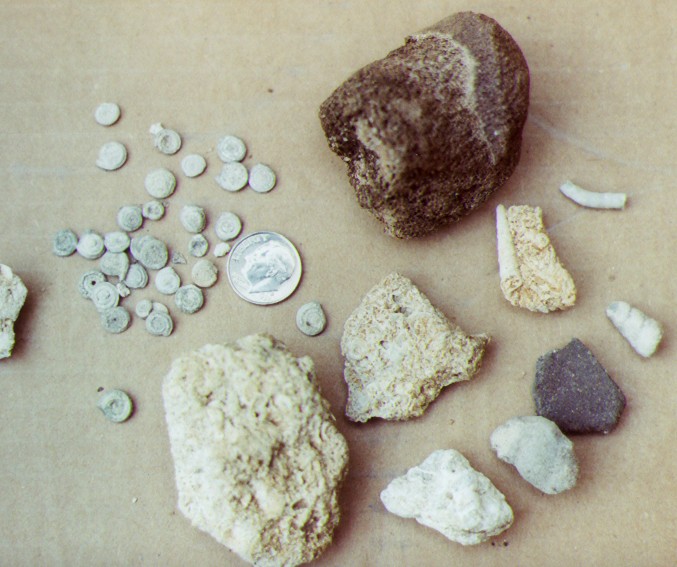
Samples from Vicki's bag.
October 2, 2004 - Lawrence and Colbert Co, AL
Stop #1 was a roadcut in Lawrence County, Alabama, where large pieces of rugosa coral in Bangor Limestone had been excavated by road construction. The site has almost been totally reclaimed, but some very nice specimens were found.

A large coral head.
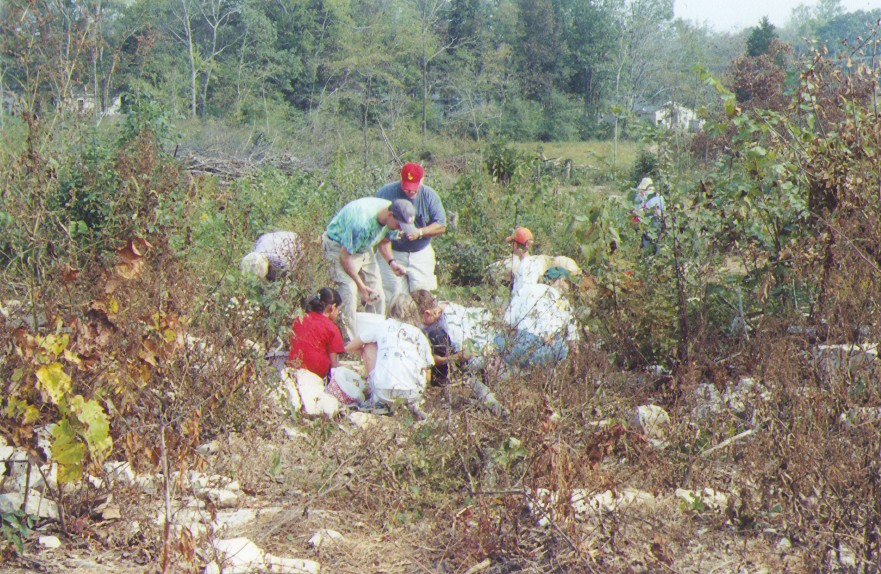
Hunting for treasures. The site has become overgrown, making it more difficult to spot the coral pieces.
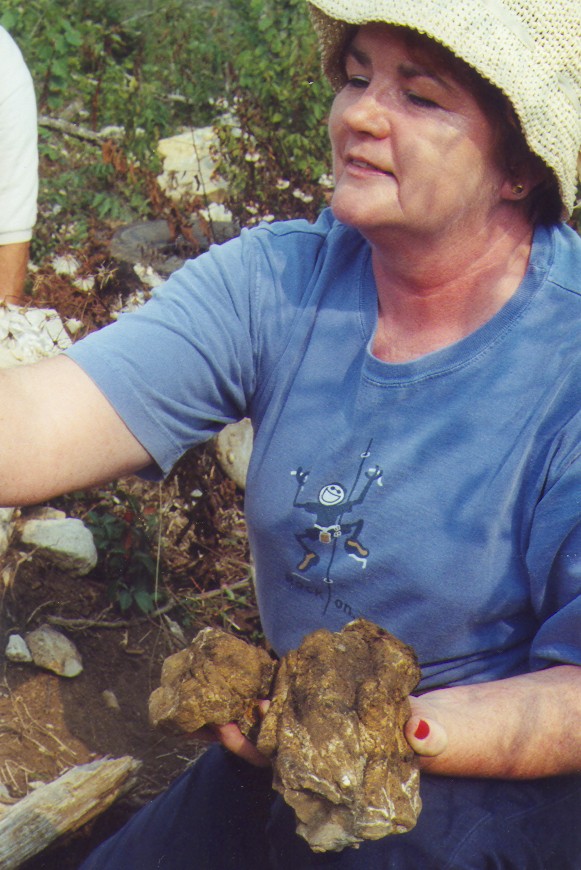
Carolyn with a couple of coral clusters.

Bobby in foreground, with James in back.

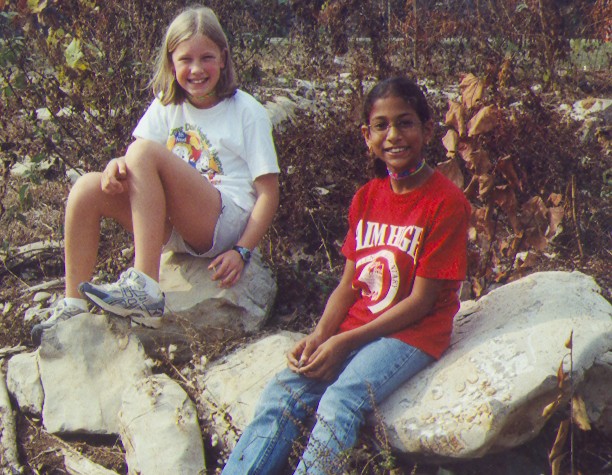
Katie and Nina, very happy with their finds! Note the large coral head underneath Nina!
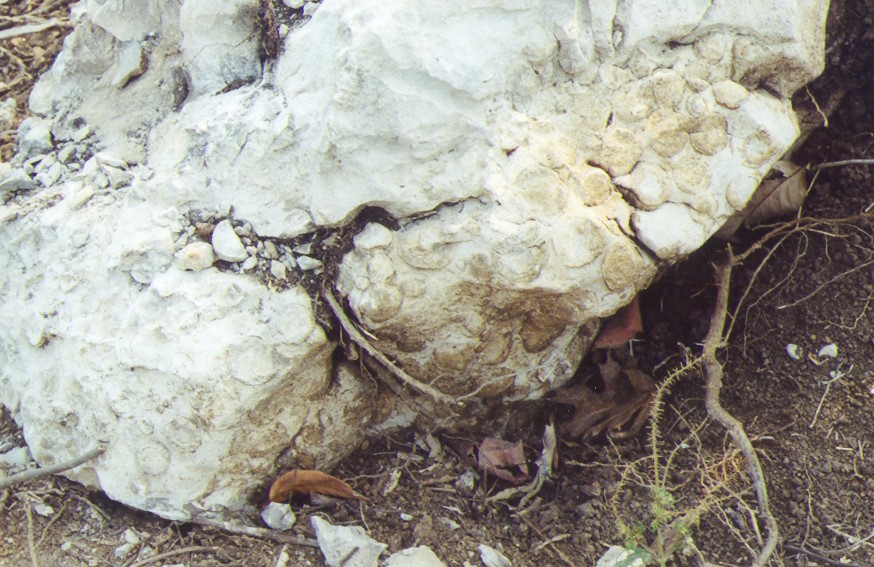
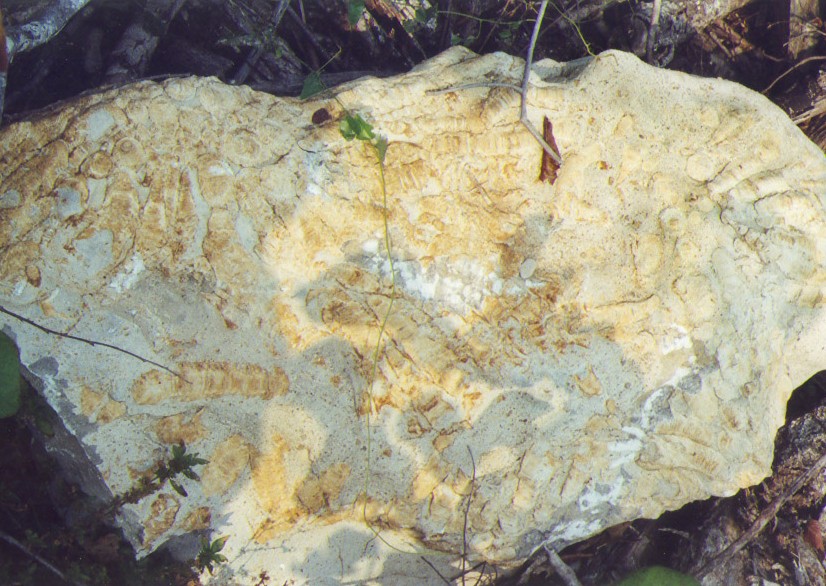
Stop #2 was a short stop, yeilding several samples of archimedes and crinoid stems, also from the Bangor Limestone.

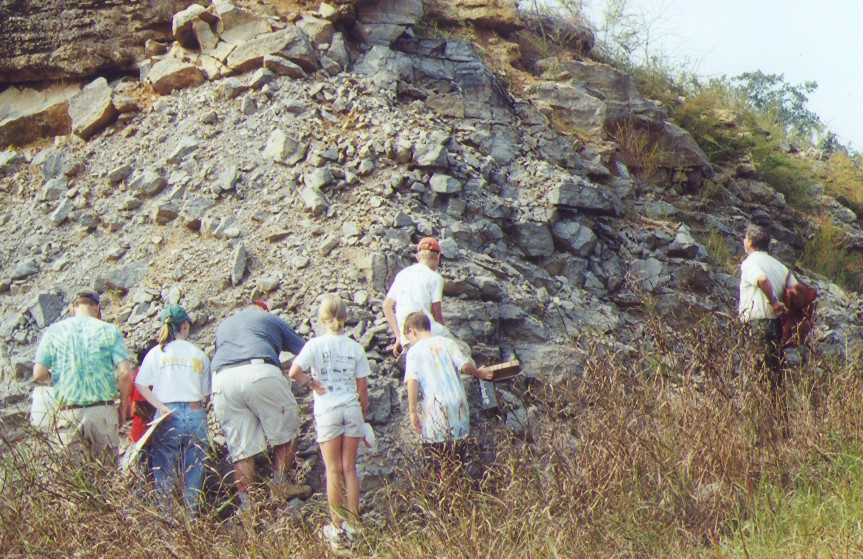
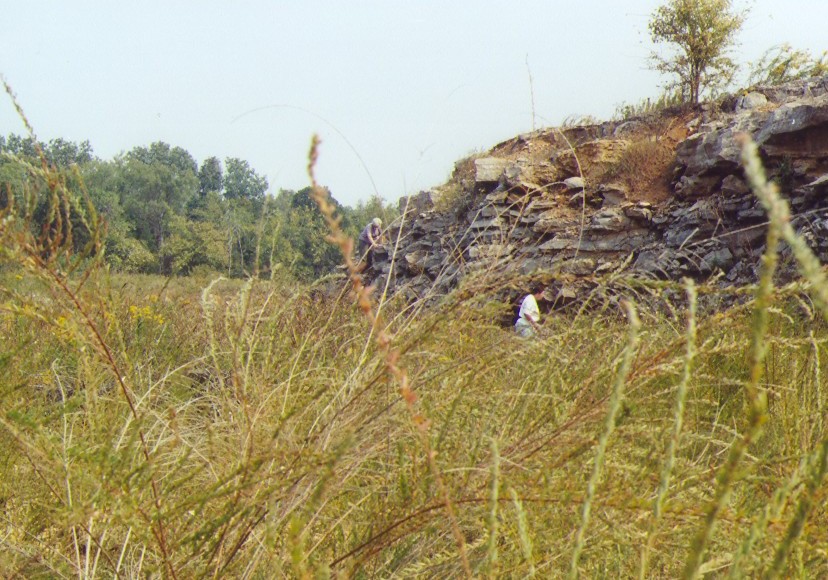
Jan and Claire inspecting this outcrop
.
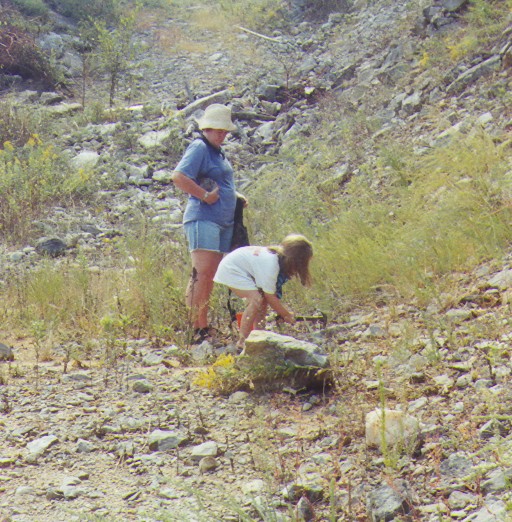
Bailey has found a nice archimedes.
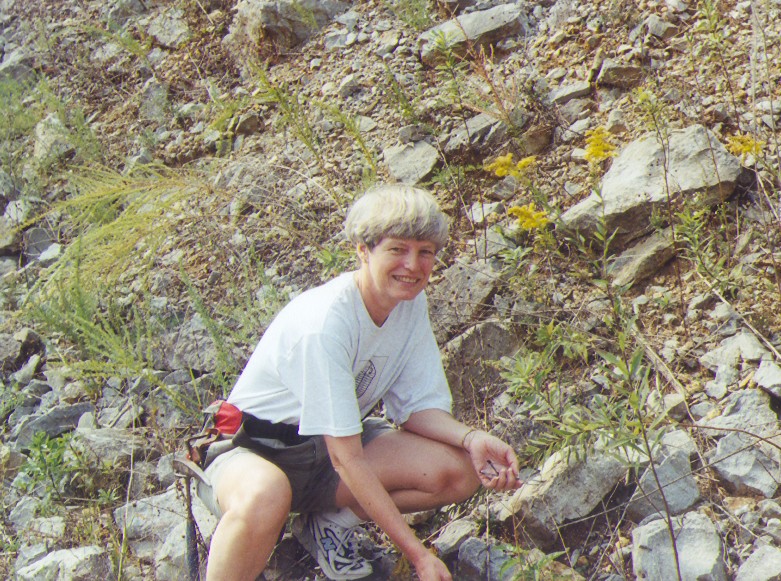
Vicki in her favorite environment, surrounded by rocks!
Stop #3 was a roadcut in Colbert County. Horned corals, blastoids, and crinoid stems were plentiful.
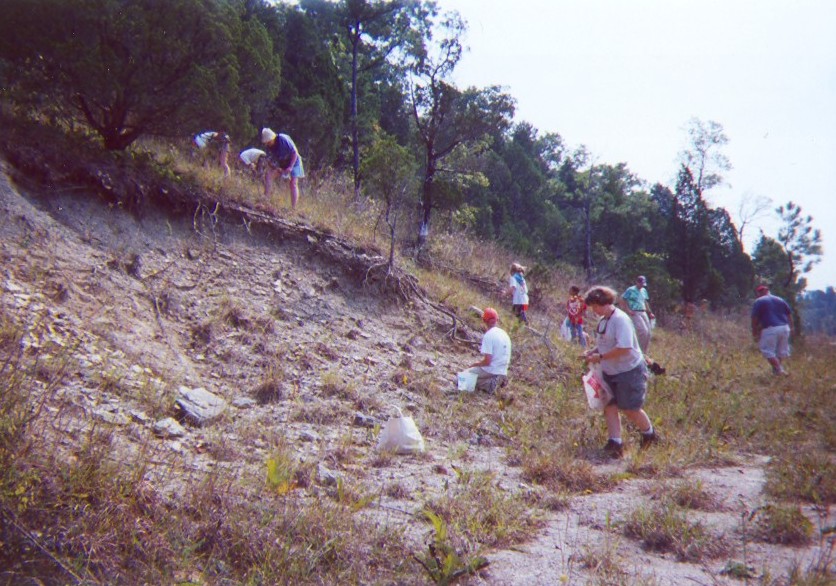
The fossils weather out, and can be found laying on top of the ground.
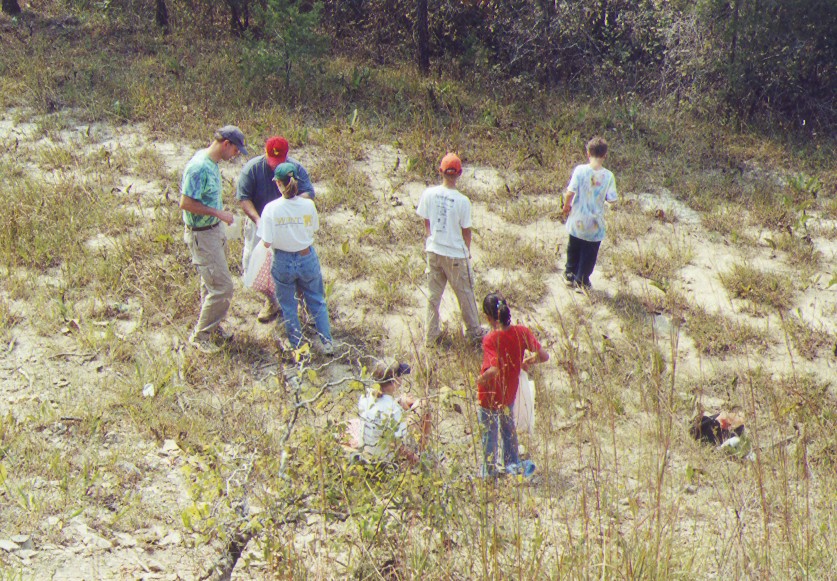
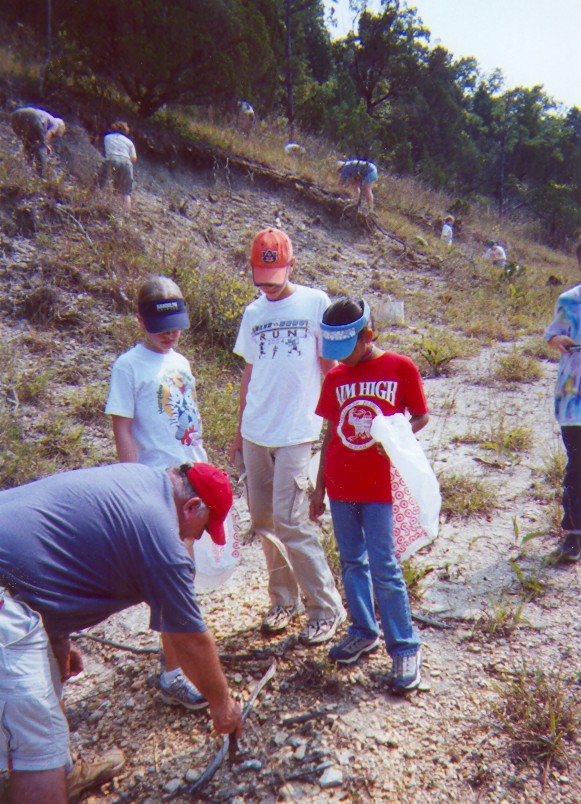
Greg is identifying specimens for some of the students.
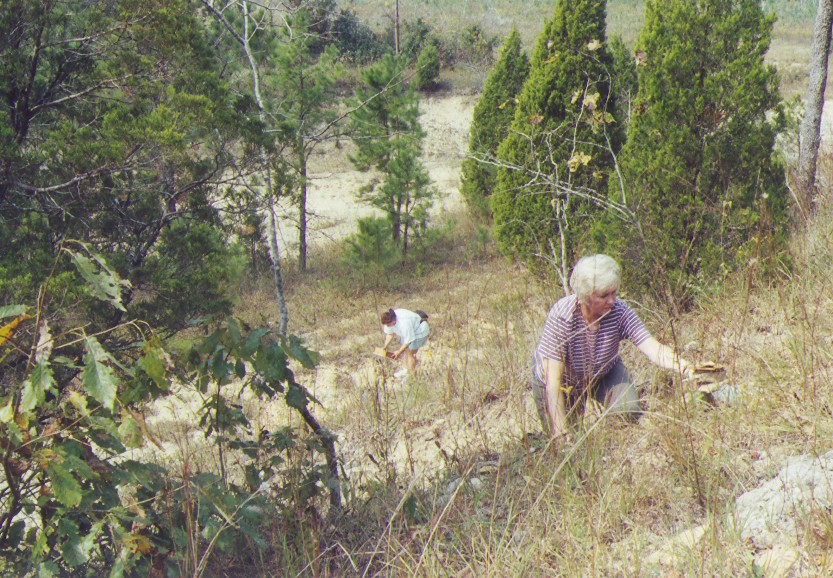
Jan climbing the hill, with Leisa in background.
Stop #4 was a different roadcut, and yeilded similar material as stop #3, such as archimedes, blastoids, brachiopods, and bryazoan fragments.

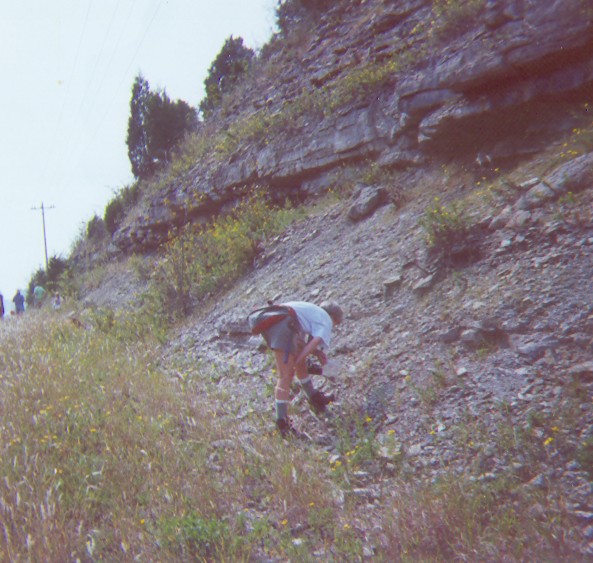

Bobby found a nice trilobite at this site.
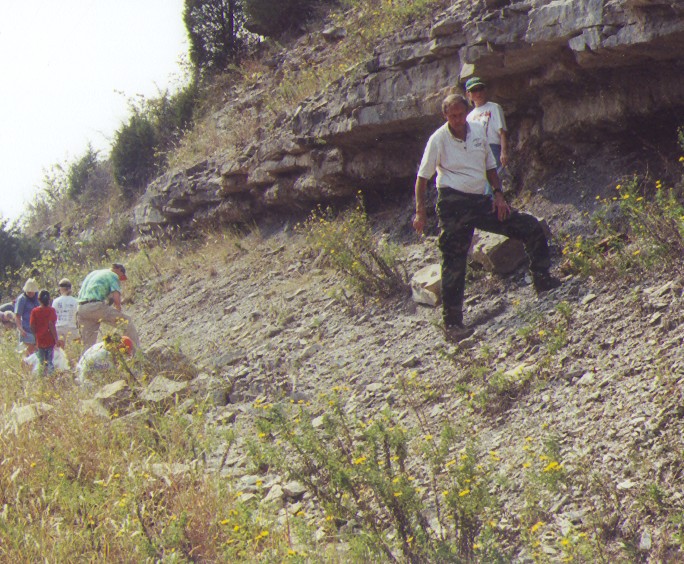
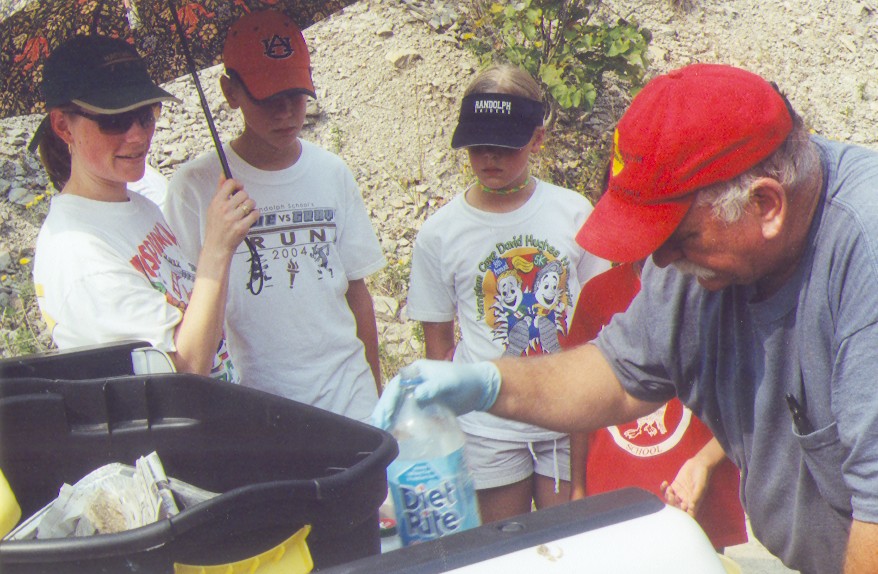
Greg is giving a short tailgate workshop on how to clean the limestone slabs found at this site with a light acid wash (that is not Diet Rite in that bottle!). Acid makes the fossils stand out nicely, but be sure to wear protective gloves and work clothes, and get proper training before trying this at home.
Stop #5 was also in Bangor Limestone, and provided a number of slabs containing broken bits of archimedes, blastoids, brachiopods, and bryazoan fragments. This site also contained numerous square brownish-red metallic crystals, which we believe to be pyrite. They are approximately 1/8 inch squares, some slightly larger.
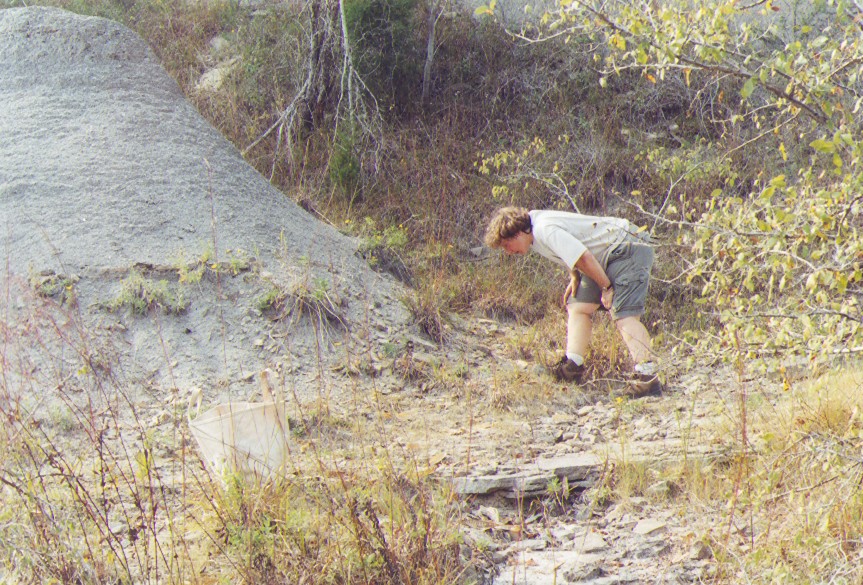

On the way home, several of us decided to visit one of the local attractions.

Yep, believe it. Only coon dogs buried here. Decoration day must have occurred recently. In addition to reading the tombstones, one can picnic under the covered pavilion or hike through the woods to the spring.
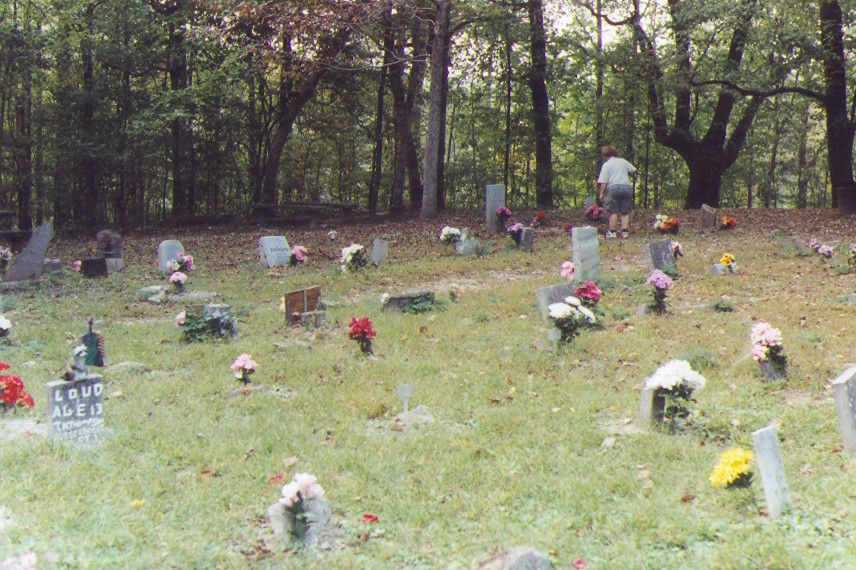
October 23, 2004 - Cretaceous Fossils, Tuscaloosa and Hale Co, AL
The creek was higher than expected when we got there, and it became
clear that wading (sometimes in some over-the-knees water)
would
be on the menu. Part of our
group chose to
sift from a bank while standing in knee deep to thigh deep water while
the
other part of our group headed downstream. The downstream group
discovered that
mother nature's engineers had built a very nice dam, thus explaining
the high
water level. Below the dam sifting was very easy.
This creek runs through the Mooreville Chalk, producing
mostly shells,
bones, shark and mosasaur teeth. Numerous shark-teeth were
found,
also
several ptychodus
teeth, LOTS of fossil clam shells and exogyra, a few fish
vertebra, bivalve steinkerns, and several gastropod steinkerns.
Almost everyone had a sieve of some kind. Only one
of us managed
to get completely dunked but claimed it was a refreshing
experience! See, kids, we aren't kidding about bringing a
change
of clothing! You NEVER KNOW!
Some brave souls tested out MRE's at
lunch.
Interesting. Our fighting folk have our deepest
sympathies!
Actually they weren't that bad.
A long day was capped off by chowing down at a
great local barbecue
place!
All in all, a fun and productive trip!
--Edited by Vicki Lais
(Photos
courtesy Vicki Lais)

First stop
was the Museum of Natural History in Tuscaloosa.
Thousands of fossils, but none we could collect! We were
pleased
to find the large mosasaur specimen was still being exhibited.
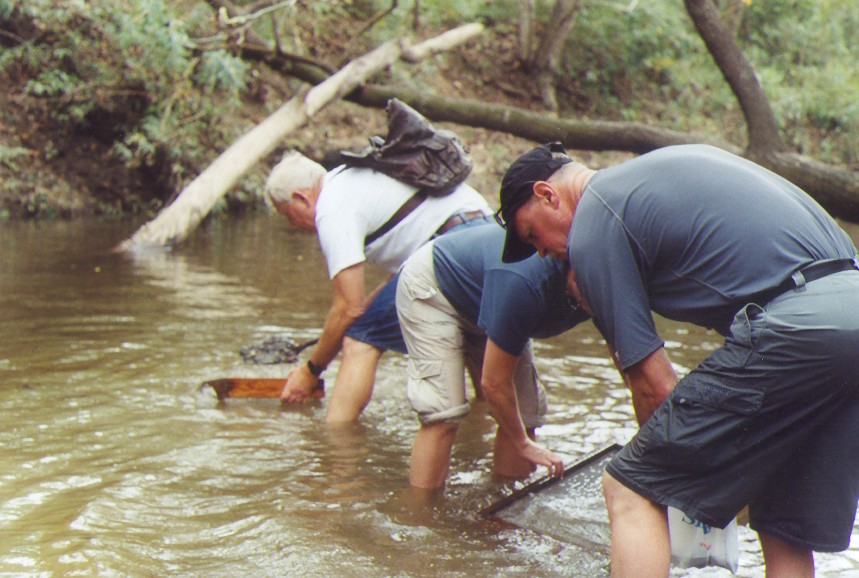
Steve, Lea,
and Glyn screening the gravel.
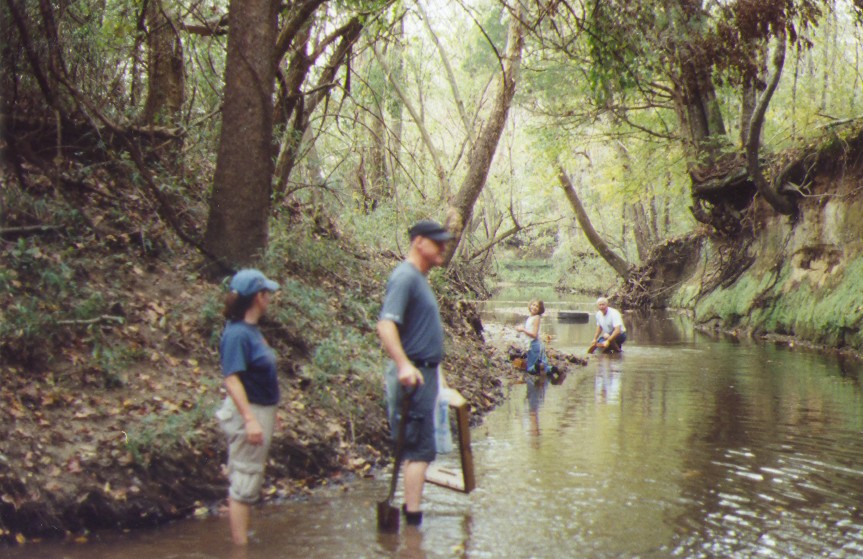
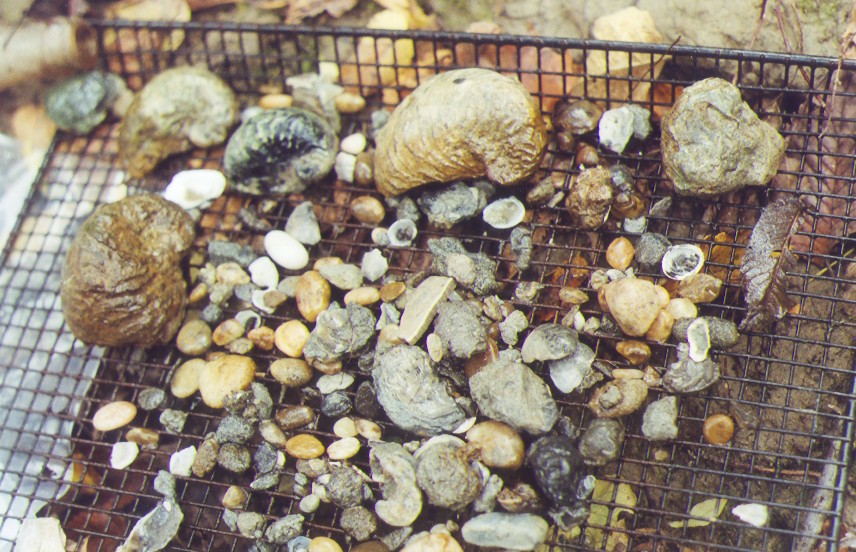
One of Nancy's screening efforts. Several large exogyra.
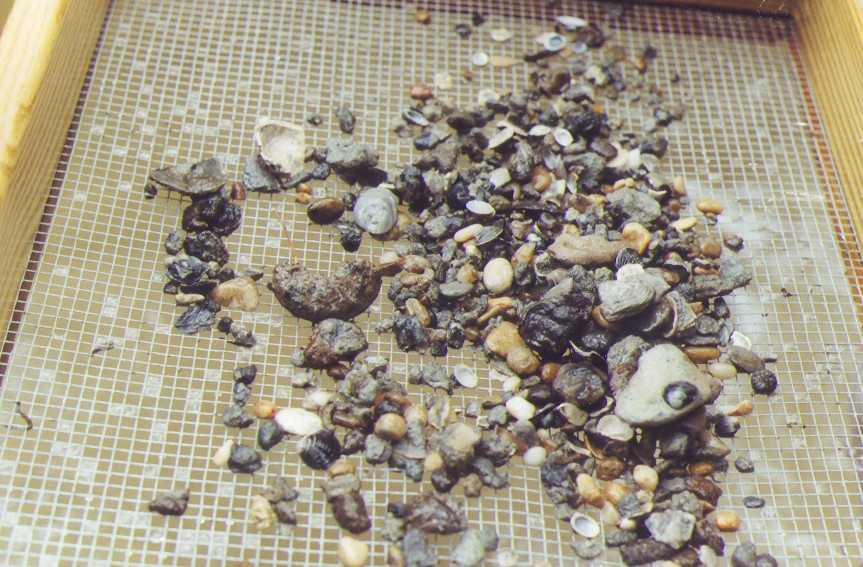
One of
Steve's hauls, note the shells and partial ammonite.

Shark and
ptychodus teeth found by Steve.
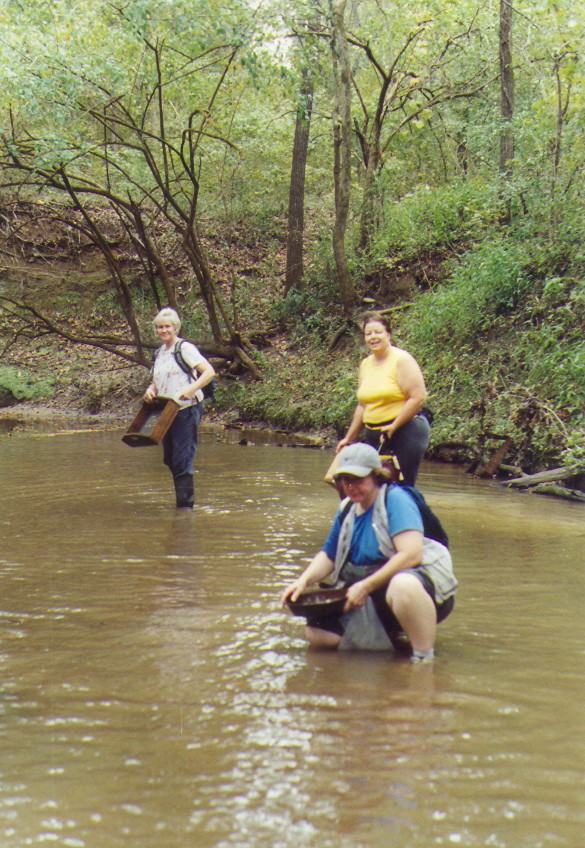
Jan, Claire,
& Leisa.

View
up the creek.
At the end of a beautiful day, we had several show-and-tell
displays.

Greg's
display.

Lea's finds,
note the mosasaur jawbone in lower right corner.
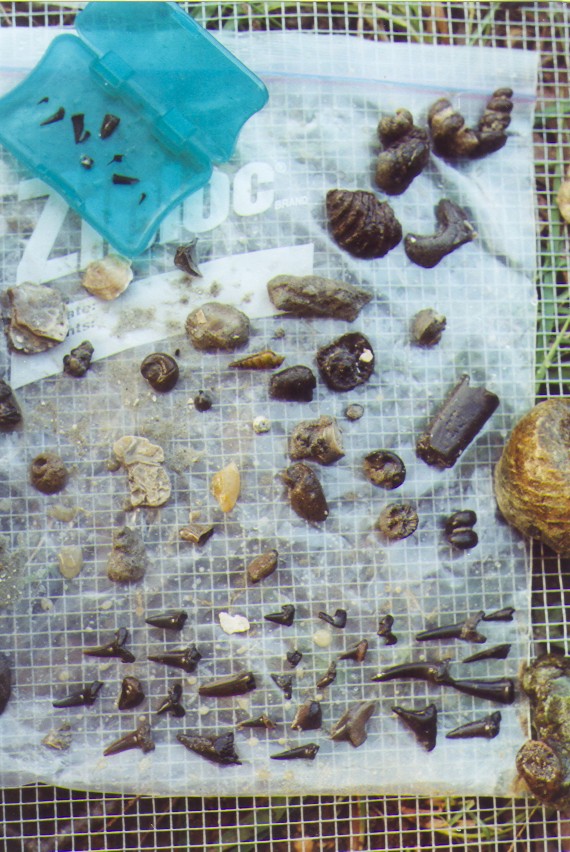
Paige's
display. She wanted to find enough shark teeth to
share
with her classmates, and she certainly accomplished her goal!
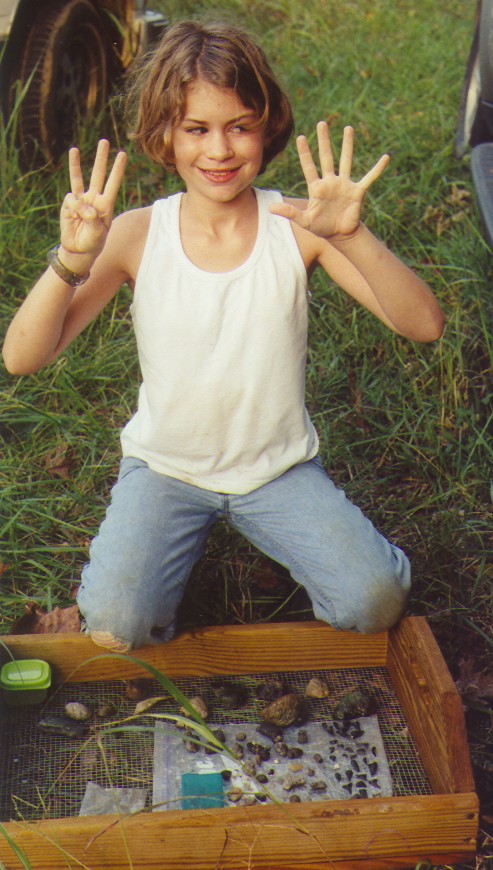
35 shark
teeth found!
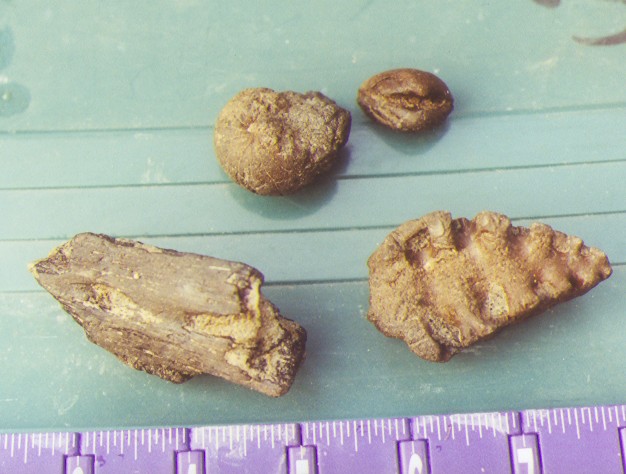

Vicki's finds.
November 15, 2004 - Meadowview Elem School, Dallas Co, AL
On November 15, 2004, Vicki Lais and Nancy Kenfield, members of the Birmingham Paleontological Society Community Education Committee, were the guests of Mrs. Woods' "gifted student" class at Meadowview Elementary School in Selma, Alabama. These are all third-graders and BPS had been invited to speak when one of the students told her teacher about seeing Nancy's collection. Vicki supplied the knowledge and experience and a LOT of samples to show and give away, Nancy supplied more samples, her own stories and a whole bunch of stuff "scored" from Ward Science, fossil books, and maps from the GSA office in Tuscaloosa.
An overview of the geological history of Alabama was given, including type of fossils found and why. We showed and passed around numerous fossil samples, including corals and a large coral head, large pieces of petrified/ permineralized wood, one covered with quartz crystals, nautiloids past and present, ammonite, calamites, echinoids, crabs, shark teeth, ptychodus teeth, exogyra, cast of a very large crinoid, rocks containing numerous bits of archimedes, shells, and crinoid hash, and some mineral specimens, including calcite and quartz with tourmaline crystals. This was the first time some of the students had ever been allowed to hold fossils, and we took some nice, sturdy ones for everyone to examine. Most of these samples were collected on BPS field trips. The general area of collecting locations were marked on a geologic map to show the diversity of Alabama fossils, to provide a simplistic way to determine which fossils are older or younger, and to emphasize the importance of knowing the location of Alabama counties. We also showed pictures of BPS members on various outings (incuding the "rope trick" adventure!), told them stories about exciting things that happened on trips, and Nancy presented a slide show of various common fossils. During the course of the day, we showed them the BPS web site, touched on the ethics of fossil collecting, and the reason why museums only list the county where the fossils are found.
THEN came their own fossil hunt! Nancy had a lab-activity kit from Ward Science that included a bucket full of small fossils and gravel, sorting trays, tweezers, and magnifying glasses. Add a little landscape sand to "stretch" the supplies, then seed the mix with a few goodies from the BPS give-away stash, and you have the recipe for an unforgettable event! The kids had a great time sieving and searching, and their exciting "finds" included echinoderms, horn coral, archimedes and crinoid parts, blastoids and a few fern fossils which were "donated" by the finders to the classroom! To end the day there were "door prize" drawings where each student could choose a fossil of their own.
Several teachers stopped by to look at the fossil display, and the principal stopped by to take pictures. Everyone was super excited about the visit. Who would have thought that kids would want to help lug your fossils around! Mrs. Woods was great...no amount of mess fazed her and everyone had a great time!--Edited by Vicki Lais
(Photos courtesy Nancy Kenfield and Vicki Lais)

Students and teacher checking out the fossil display as we are setting up.

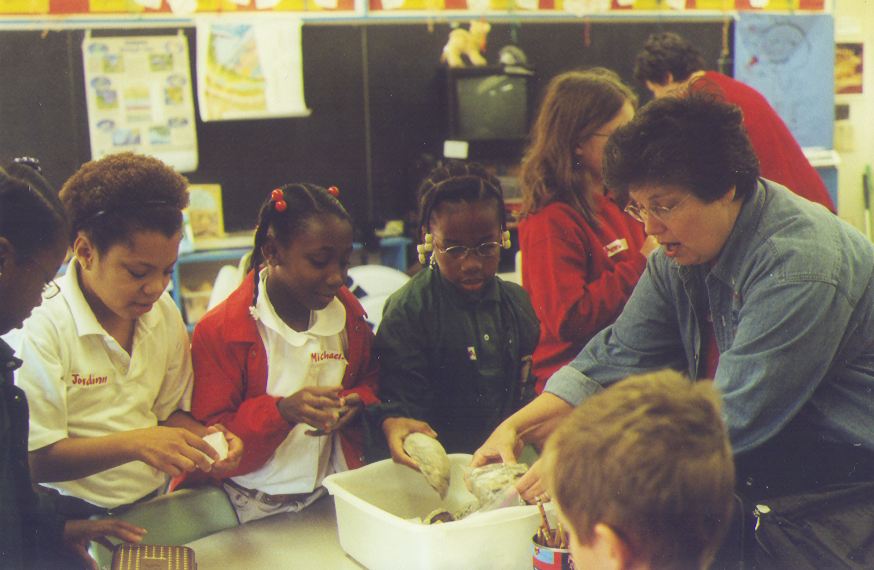
A lot of assistance was provided in laying out the specimens. What they didn't know, was that this box contained the fossils that would be given away at the end of the day! Later in the day, the calcite crystal being intently examined had a large amount of pressure applied to it (i.e, we hit it with a rock hammer) to show how this mineral splits into smaller crystals of the same shape.

Vicki explaining the color banding on the Alabama geologic map.

"Sticky's" were added to the map as a particular fossil specimen was discussed.
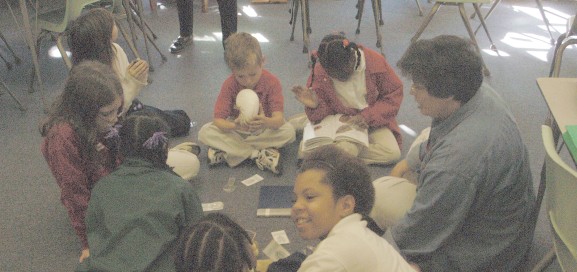
Examining nautaloids and echinoids.
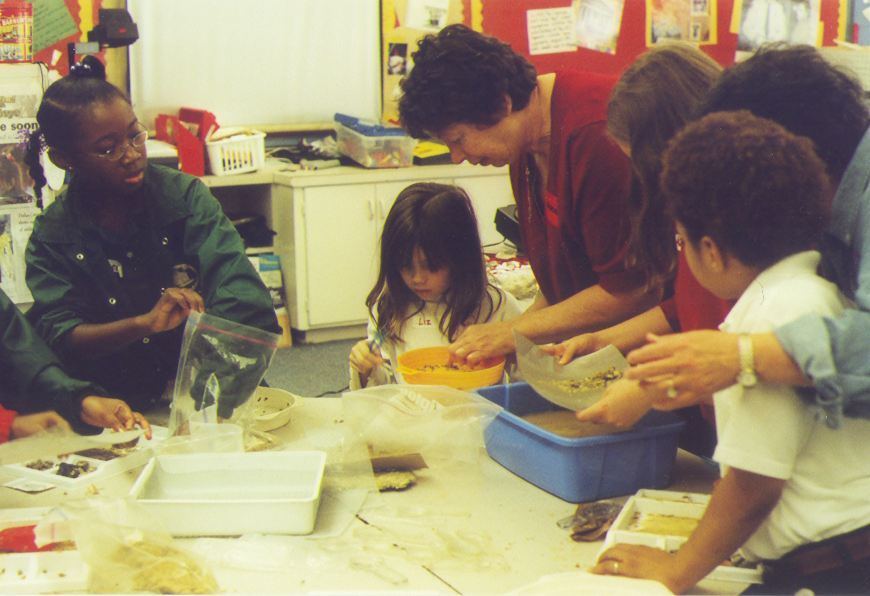
Nancy assisting with screening and sorting the different fossil specimens.
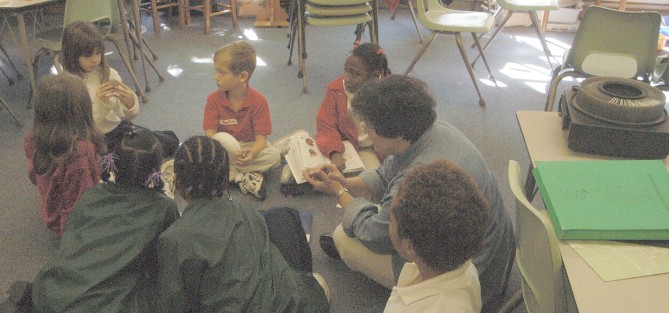

Examining the fossils. An ammonite was inside this split nodule.
November 20, 2004 - Mississippian Fossils, St. Clair Co, AL
Donning
orange and blue, red and white, or...mud and well, a little more mud,
the BPS
explored a new site in St. Clair County, Alabama. The
weather was just a tad misty after our outing but cool and comfortable
during
our adventure. Our fearless leader led us
to a Mississippian age roadcut yeilding some of the
largest horn coral that I have seen, with a perfect geologic example of
"uplift". Several varieties of coral were found, and a number
of
whole brachiopods were collected from the layers around the Tuscumbia
Limestone. There were also hollowed out molds in the Ft.
Payne
chert where archimedes or crinoids had once been.
None
of
our members minded that our actual collecting time was shorter than on
many of
our trips, as most members were eager to put their orange and blue or
red and
white clothing to use as they "collected some radio and television
time", because there was some
important football game being played....tiny
mumble...mumble...#*%...how did we
manage to vote on this weekend for the field trip in the first
place????????
MY TEAM WON!!! How 'bout yours?
--Edited by Vicki Lais
(Photos courtesy Steve Corvin and Vicki Lais.)

The group before playing in the red clay!

Leisa and
Nancy checking for fossils weathered out of the matrix.
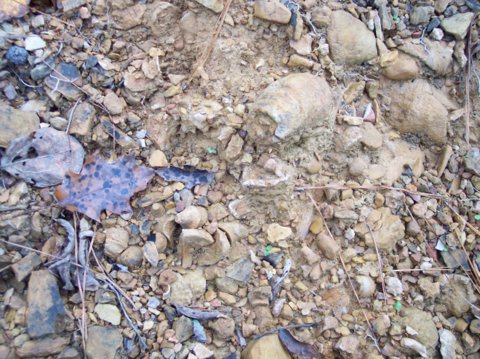
Coral pieces
covering the ground in this area.
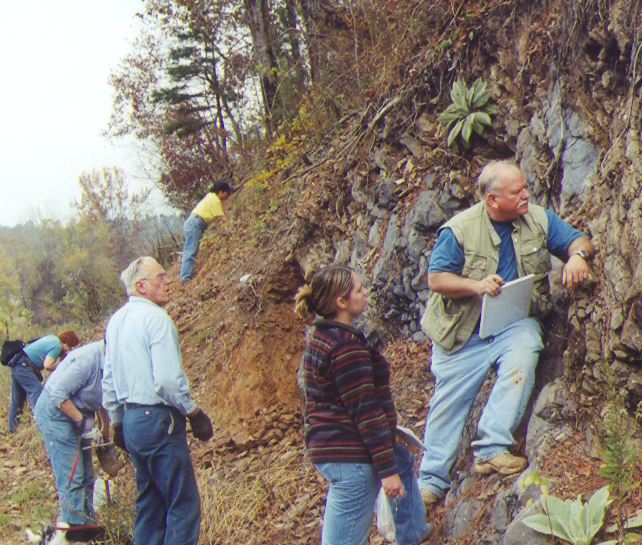
Getting a
closer look at the geologic layers.

Lee with her
finds.
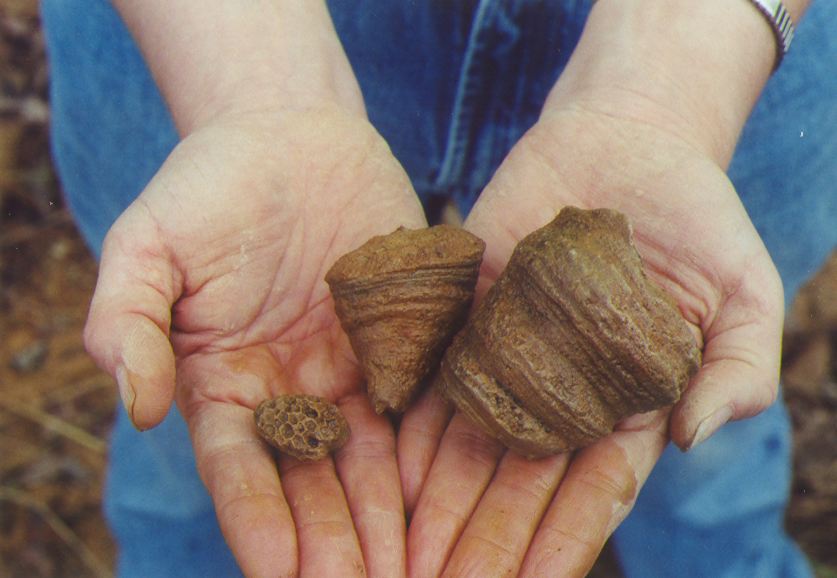
A closer look
at the nice coral specimens found by Lee.
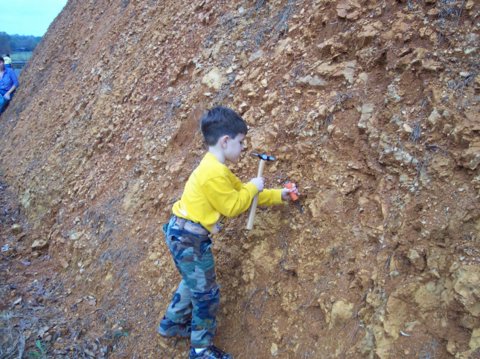
Steve is
determined to get that fossil!
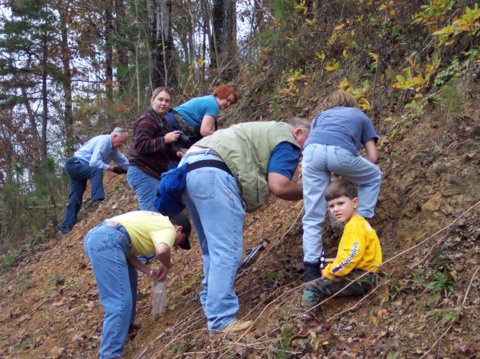
One of the
better collecting spots.
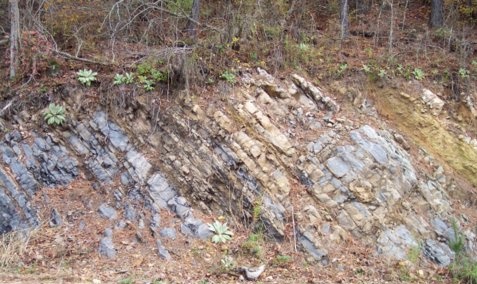
Layers of
limestone, shale, and mud tilted upward by geologic forces,
and exposed at a roadcut. "Newer" rock is to the right,
"older"
rock is to the left. Rock layers were horizontal when they
were
initially formed.
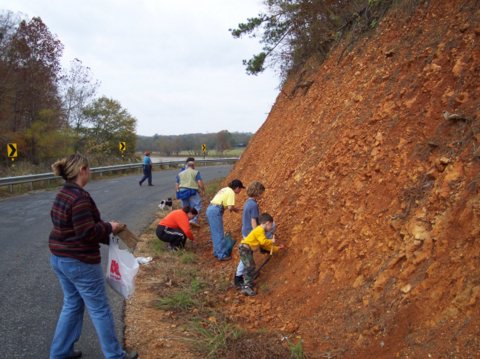
One of the
muddier collecting spots!



